NFT flipping has become one of the most talked-about strategies in the digital asset space, attracting traders who want to turn quick opportunities into real profits. But with the NFT market constantly changing, knowing where to start can feel overwhelming. This guide breaks down everything beginners need to know about NFT flipping in 2025, from how to identify promising projects and analyze market trends, to building a strategy that minimizes risks while maximizing potential gains. Whether you are brand new to NFTs or looking to sharpen your trading skills, this step-by-step guide will help you understand the fundamentals, avoid common mistakes, and confidently navigate the NFT market.
Why You Should Keep an Eye on “Mythic Piece” – A New NFT Experience Like No Other:
The NFT space is constantly evolving, but few projects truly break the mold. “Mythic Piece” is one of those rare gems – a project shrouded in mystery, yet undeniably intriguing. While many NFT collections simply offer digital assets, “Mythic Piece” hints at something far more immersive and dynamic.
This is not just another collection; it's the beginning of an adventure. The project is designed to unveil its secrets over time, rewarding those who engage early and follow its development. If you have an eye for innovation in the NFT world, this is something you won’t want to miss.
To get a first glimpse of the journey ahead, watch the official launch video: “Awaken! Rise! – The Mythic Pieces Call... Will You Answer?!”
This short yet powerful teaser sets the tone for what’s to come: an experience that promises to go beyond the ordinary.
For now, details remain scarce, adding to the project's allure. But what we do know is that “Mythic Piece” is set to offer an experience unlike anything seen before in the NFT space. With its unique vision this could be one of the most exciting projects to emerge.
The best way to stay ahead? Follow “👑 Mythic Piece 🔱” on:
- X.com: https://x.com/mythicpiece
YouTube: https://www.youtube.com/@MythicPiece
TikTok: https://www.tiktok.com/@mythic_piece
And if you want to secure a place in this unfolding journey, now’s your chance – the Whitelist is still open, offering lucky participants a chance for free minting.
The adventure is only just beginning. Will you be part of it?
Table of Contents:
- Understanding NFT Flipping in 2025:
- State of the NFT Market in 2025:
- Choosing the Best Blockchain for NFT Flipping:
- Ethereum – blue chips, deep liquidity, and DeFi integrations:
- Solana – speed, very low fees, and compressed NFTs for scale:
- Bitcoin Ordinals and Runes – experimental, headline-grabbing, high risk:
- Polygon, Base, Ronin, Immutable and other emerging chains – niche liquidity, gaming and utility plays:
- Tools and analytics that matter in 2025:
- Quick chain-by-style cheat sheet:
- Final thought, from one flipper to another:
- Best NFT Marketplaces and Tools for Beginners:
- Proven NFT Flipping Strategies for Beginners in 2025:
- Mint-to-Flip Strategy – Free Mints, Allowlists, and Gas Management:
- Secondary Market Strategies – Floor Bids, Trait Sniping, and Collection Offers:
- Event-Driven Trading – Partnerships, News, and Airdrops:
- Chain Rotation and Seasonal NFT Market Trends:
- Reward Programs and Liquidity Mining – Points, Diamonds, and Seasons:
- Using NFT Lending and Leverage Safely:
- Final Thoughts:
- Risk Management for Successful NFT Flipping:
- NFT Security and Wallet Safety in 2025:
- Hot vs cold wallets – build a simple, safe setup:
- Secure signing – know what you are approving, every time:
- Revoke old approvals, clean up connections, reduce blast radius:
- Phishing, scams, and social engineering – the current playbook:
- Step-by-step secure minting checklist:
- Extra hygiene that compounds over time:
- Bottom line:
- How to Research and Evaluate NFT Projects:
- Quick first-pass checklist (10 minutes):
- Checking the team, backers, and community strength:
- Smart contracts, audits, metadata, and storage reliability:
- Supply, mint price, royalty structure, and economics:
- Roadmaps, utility, and long-term sustainability:
- Practical tools and signals to use right now:
- Final practical checklist you can paste into your workflow:
- A quick, honest anecdote:
- Closing note:
- NFT Taxes and Regulations in 2025:
- Big-picture rules you need in your head first:
- How NFT profits are taxed in major jurisdictions:
- Income vs capital gains: how that actually plays out for flippers and creators?
- Regulatory and reporting trends that affect traders:
- Tools and best practices for record-keeping and compliance:
- Quick FAQ for traders:
- Final actionable checklist before you trade tomorrow:
- Ethical and Sustainable NFT Flipping:
- Step-by-Step Guide: Your First NFT Flip in 2025:
- Advanced NFT Flipping Tactics for 2025:
- Frequently Asked Questions About NFT Flipping in 2025:
- Q1. Is NFT flipping still profitable in 2025?
- Q2. How do I choose the right NFTs to flip?
- Q3. What’s the best platform for flipping NFTs?
- Q4. How can I avoid scams and counterfeit NFTs?
- Q5. Should I use bots or proxies for flipping?
- Q6. What are the tax implications of NFT flipping?
- Q7. Can I flip NFTs with a small budget?
- Q8. What are the risks involved in NFT flipping?
- Q9. How do I track my NFT portfolio?
- Q10. What’s the future of NFT flipping?
- Final Takeaway – Beginner’s Checklist for Profitable NFT Flipping:
- NFT Glossary for Beginners (ERC-404, ERC-6551, Ordinals, Runes, cNFTs):
Understanding NFT Flipping in 2025:
The 2025 snapshot: what kind of market are you walking into?
If you feel like the NFT market keeps changing every time you blink, you are not wrong. In Q2 2025, total NFT trading volume fell to about $2.3 billion, down 45% quarter over quarter, yet the number of sales jumped to roughly 14.9 million, up 78%. In plain English, more trades happened, at lower average prices, and liquidity concentrated in bursts. That is the kind of tape you are flipping into this year.
Step back and zoom out, and the first half of 2025 still tallied an estimated $19.8 billion in NFT sales across chains, which tells you the space is active, just choppier and more selective than the peak hype years.
Two structural shifts matter for flippers right now:
- First, creator royalties are often optional on major marketplaces unless a collection’s smart contract enforces them, which changes your net returns per trade. OpenSea’s own help center walks through when fees are enforceable and when they are not, so always check the collection’s setup.
- Second, incentives drive behavior. Rewards programs and point systems, like Magic Eden’s Diamonds and various airdrops that reward trading, listing, and loyalty, still shape volume and attention. If you chase points, you are competing with other farmers, so price action can be noisy.
Cross-chain flavor also matters. Bitcoin activity broadened in 2024 with Ordinals and the Runes protocol for fungible tokens, which pulled traders into BTC ecosystems and changed where liquidity shows up first. On Solana, compressed NFTs dramatically cut minting costs at scale, so you will see more low-cost, high-supply drops, which behave differently than small, premium Ethereum collections.
What is NFT flipping, and how does it actually work?
Think of flipping as short-to-medium-term trading of digital collectibles for a spread. The goal is simple: buy below what you can later sell for, then repeat without getting chopped up by fees or illiquidity.
Here is the simple flow most beginners use, with a few 2025 tweaks:
- Find the right lane: Pick your hunting ground first, not the collection. Maybe you track small-cap Solana mints that use compressed NFTs, or you focus on established Ethereum collections with heavy bid depth. Your lane dictates risks, fees, and the tools you need.
- Filter for momentum you trust: Watch fresh mints, listings velocity, unique buyers, and real wallet activity. Incentive seasons can fake momentum, so treat volume spikes during reward pushes with healthy skepticism.
- Set your entries: For mints, decide in advance if you are taking allocation or waiting for post-mint dips. For secondary buys, anchor to clear levels, like prior consolidation zones or areas with thick bids.
- Know your net: Calculate royalties, marketplace fees, and gas or network costs before you click. If royalties are optional, confirm whether a collection enforces them at the contract level, because that changes your break-even.
- Pre-plan exits: Write down two target scenarios: a base-hit take-profit for quick churn, and a runner plan if the collection attracts sustained demand. Decide a hard stop to avoid riding a round-trip.
- Protect the downside: Use reputable marketplaces and wallets, avoid blind links, and remember that manipulation and scam tactics still exist in crypto markets. Chainalysis continues to highlight market manipulation in new tokens and persistent scam vectors, so skepticism is a feature, not a bug.
A quick sanity check many traders use: if you cannot explain in two sentences who the natural buyer after you is, you probably do not have an edge.
What changed in 2025, and why it matters for beginners?
- Royalties are not a constant: Your net profit per flip depends on the fee model of the marketplace and the collection’s contract. Optional royalties mean thinner margins can work, yet they also reduce creator incentives if not enforced, which can affect long-term support. Always read the collection’s fee rules before sizing a trade.
- Incentives drive weirdness: Points, diamonds, and airdrops reward certain actions, like listing on native order books or keeping “loyalty” high. That can pump volume while muting price discovery, since people farm behavior rather than value. Trade it if you like, just label it for what it is: an incentive trade, not a fundamental bet.
- Cross-chain liquidity is real: Ethereum still anchors blue chips, Bitcoin captured energy with Ordinals and Runes, and Solana’s low fees plus compressed NFTs enable mass distribution drops and micro-price action. Your tooling should match the chain, and your expectations should match fee realities and typical hold times on that chain.
- Unit economics favor speed: With Q2 showing more sales but lower average ticket sizes, flipping looks more like high-frequency base hits than home runs. Your edge is fast decision making, tight risk, and knowing where real buyers sit, not guessing tops.
Pros and cons of NFT flipping for beginners:
The upside:
- Clear playbook: Entries, exits, and risk rules translate well from traditional trading, and you can practice on lower-priced assets or chains with low fees to learn without nuking your bankroll.
- Plenty of catalysts: New mints, seasonal incentives, and cross-chain narratives keep the board lively, which creates repeatable, short-term setups.
- Data on-chain: You can verify wallets, flows, and listing behavior directly, which helps you avoid obvious traps and copy what works.
The downside:
- Noisy signals: Incentive farming can inflate volume without real demand, so many breakouts fade once rewards dry up.
- Thin liquidity pockets: Many collections trade like small caps. When the music stops, spreads widen, and exits slip. Q2’s stats show how quickly conditions can change.
- Real security and integrity risks: Phishing, fake mints, and manipulative trading patterns still happen. Use allowlists and official links, verify contracts, and assume that if a deal feels too sweet, someone is farming you.
Bottom line: Flipping NFTs in 2025 is less about chasing fireworks, more about stacking small wins while respecting the new rules of the road. Learn the fee model of each collection, understand how incentives tilt the board, choose a chain and niche that fit your budget and speed, then treat every trade like a business decision. The market is still alive, just pickier, and that actually favors disciplined beginners who keep it simple.
State of the NFT Market in 2025:
If you took a breather after the 2021 mania and peeked back in, you probably noticed the market looks familiar, yet very different. Liquidity now moves across multiple chains, royalties are a live negotiation between creators and traders, and new standards keep expanding what an NFT can be. Here is the lay of the land, with the stuff that actually matters if you plan to flip responsibly this year.
Key Trends Driving NFT Trading This Year:
- Cross-chain is default, not exotic. Capital rotates between Ethereum, Solana, and Bitcoin ecosystems, with Base and other L2s pulling in bursts of activity. Data dashboards show continued multi-chain share shifts during 2025, rather than one clear winner.
- Metaverse and gaming heat up again. DappRadar’s latest reads show metaverse trading jumping, and Q2 2025 gaming metrics improving, which usually brings fresher mints, cheaper entry points, and more active secondary markets.
- Points, airdrops, and loyalty matter. Rewards programs like Magic Eden Diamonds and token distributions such as Tensor’s TNSR airdrop turned trading behavior into an “earn while you flip” meta. Understanding how points calculate, and the real value of those points, is now part of edge.
- Bitcoin culture adds flow. Ordinals started it in 2023, Runes expanded it in 2024, and in 2025 Bitcoin marketplaces and wallets keep integrating this activity, adding another venue for rotations.
NFT Liquidity and Trading Volumes Across Chains:
- Total market pulse. Global volumes remain cyclical. CryptoSlam’s monthly index shows 2025 swinging month to month, with June 2025 posting hundreds of millions in sales, followed by rotation across chains rather than a single trend line. Read monthly context rather than anchoring to a single day.
- Where the flow goes. Aggregated datasets track share moving between Ethereum, Solana, and Bitcoin throughout 2025. Ethereum stays the deepest pool for high-value art and established collections, Solana captures high-velocity trading and lower fees, while Bitcoin continues to support unique inscription and Runes activity.
- Chain-specific highlights. Messari’s Solana report for early 2025 documented strong NFT activity that set the tone for the year, with Solana marketplaces gaining share and trader tools improving fills. That set expectations for faster flips and tighter spreads on SOL.
Marketplace Fees, Royalties, and Incentives in 2025:
- Royalties are not uniform. OpenSea deprecated its on-chain enforcement tool in 2024, which left royalties optional on many collections. That decision still shapes 2025 pricing and creator strategies, since flippers often prefer low-fee venues while some creators seek enforcement.
- Creator-friendly enforcement exists. A notable counterweight came from partnerships like Yuga Labs with Magic Eden to enforce royalties for its ecosystem, a move that signaled buyers should expect enforced fees on specific marketplaces.
- Rewards affect effective fees. Diamonds on Magic Eden and similar point systems can offset fees or unlock perks. Tensor’s multi-season points that culminated in TNSR turned active trading into a pipeline for token exposure. Treat points as part rebate, part optional upside, not as guaranteed yield.
New NFT Standards and Innovations:
- ERC-6551, token-bound accounts. This standard lets an NFT control its own smart-account, so it can hold assets, execute actions, and carry an on-chain inventory. That is powerful for gaming assets, identity, and modular portfolios that move with the NFT.
- ERC-404, fractional-like liquidity experiments. These hybrids link ERC-20 style fungibility with ERC-721 uniqueness, which can make high-priced NFTs more tradable. It remains experimental and not a finalized ERC, so size positions accordingly.
- Solana compressed NFTs, or cNFTs. Compression dramatically cuts minting and storage costs, which is why you see large-scale drops for tickets, loyalty, and in-game items on SOL. Lower cost inventory can mean more flipping opportunities with smaller tickets.
Popular Use Cases – Gaming, Music, Tickets, and Real-World Assets:
- Gaming. Q2 2025 reports show blockchain gaming activity rising again, with ecosystems like Ronin and Immutable drawing players and traders. For flippers, that means watchlist mints tied to live games, not just promises.
- Music and fan engagement. Catalogs and platforms continue to use NFTs for access and collectibles. Liquidity is uneven, so treat these as longer holds unless you have a catalyst like a tour, a major feature, or a drop with strong collector overlap.
- Tickets and loyalty. Tokenized tickets and membership passes keep gaining traction because they are cheap to issue and easy to verify. Solana’s compression framework supports these high-scale drops, which creates frequent, small-cap flip setups.
- Real-world assets. Tokenization is not only for bonds. Property shares, luxury goods, and other RWA pilots are growing. Traditional finance coverage in 2025 notes steady institutional progress, which is relevant because compliant marketplaces may route more volume to tokenized assets that look and feel like NFTs.
How I would trade around this: I keep one watchlist per chain, organized by reward meta, royalty policy, and catalyst type. I also log where my points accrue, since airdrop seasons can change your effective cost basis. Finally, I read chain-level data weekly, not daily, because one spicy day can fool you into buying tops.
The goal is simple: understand where liquidity circulates, then swim with it, not against it.
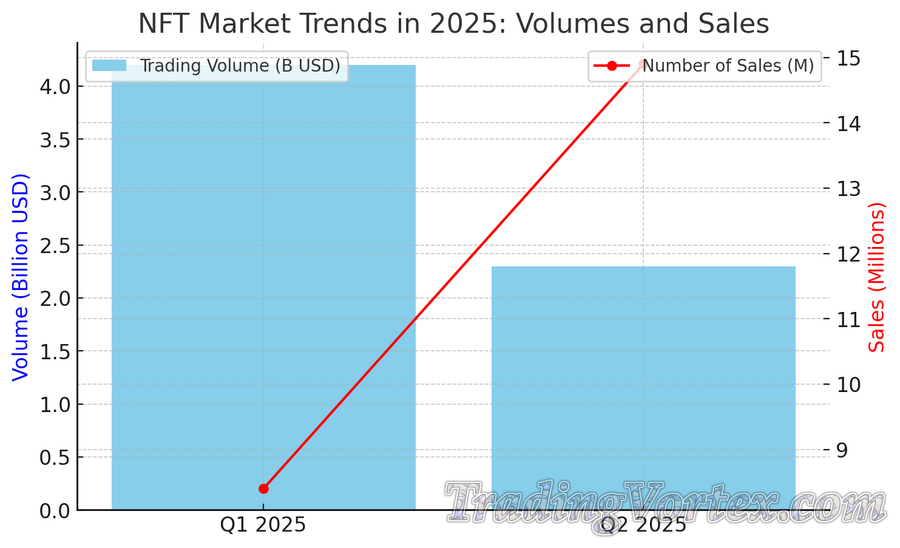 NFT Market Trends in 2025 – Volumes and Sales:
NFT Market Trends in 2025 – Volumes and Sales:
♦ The blue bars show total trading volume in billions of dollars. Notice how it dropped sharply from Q1 to Q2 2025.
♦ The red line tracks number of sales in millions, which actually increased despite lower volumes.
♦ What this means: the average ticket size is shrinking, and flipping is shifting toward higher activity, lower-value trades, especially across Solana and other low-fee chains.
Choosing the Best Blockchain for NFT Flipping:
Picking the right blockchain is one of the single most important tactical choices you will make as an NFT flipper. It determines your fee curve, who the buyers are, how fast you can move, what tools you can use, and how easy it is to exit a position. Below I walk through the major chains in 2025, explain what each one is good for when you are flipping, and give practical tips so you can match chain to strategy and bankroll.
How to decide, fast: Look for these things first: active liquidity on the marketplaces you plan to use, predictable fee structure for your ticket size, reliable tooling and analytics, enforced or optional royalties if that matters to your margins, and wallet/marketplace support for the token standard you are buying. Use marketplace rankings and chain-level dashboards to confirm where volume lives before you commit.
Ethereum – blue chips, deep liquidity, and DeFi integrations:
What to watch out for: native gas and marketplace fees can be high for small-ticket flips, so size your trades accordingly, or use L2s and rollups when possible to avoid eating margin. Also note that royalty enforcement has been changing industry-wide, make sure the marketplace or contract you are trading enforces the fees you expect.
Practical tips: if you trade higher-value pieces, use protocol-level lending and escrow services to reduce counterparty risk, and monitor aggregated marketplace dashboards to find where bids concentrate before you sell. For quick flips, consider Ethereum rollups or Layer 2 marketplaces that reduce transaction costs while keeping liquidity.
Solana – speed, very low fees, and compressed NFTs for scale:
What to watch out for: compressed NFTs may not yet be supported the same way by every wallet or marketplace, and tooling or indexing for some cNFT data is still improving. That can complicate discovery and verifications, so verify marketplace support and how metadata is served before you buy.
Practical tips: keep a narrow watchlist of Solana mint series that have clear distribution rules, and use Solana-native marketplaces and indexing tools to track real buyer activity; micro-tick flips only work if you can verify reliable fills and quick off-ramps.
Bitcoin Ordinals and Runes – experimental, headline-grabbing, high risk:
What to watch out for: tooling and liquidity are still more fragmented than on Ethereum or Solana, marketplaces are younger, and fees or network dynamics can be unusual because Bitcoin was not built originally for NFT-style data. That increases execution and custody risk for fast flips.
Practical tips: treat Bitcoin NFT activity as experimental allocation, do extra due diligence on the inscription indexing service and marketplace you use, and avoid over-sizing trades unless you can identify a clear buyer on that specific Bitcoin marketplace.
Polygon, Base, Ronin, Immutable and other emerging chains – niche liquidity, gaming and utility plays:
What to watch out for: niche chains often have fragmented marketplaces, and liquidity can be concentrated in a handful of active collections or single-game economies. That makes exit planning crucial, since you might find a crowded buy side but a thin sell side when you want out.
Practical tips: if you focus on gaming assets, learn the game fundamentals and player economy, because real game activity often drives secondary demand. For L2s like Base, watch adoption signals from major wallets and marketplace listings to confirm that liquidity is growing before you scale positions.
Tools and analytics that matter in 2025:
You do not want to trade blind. Dune and community dashboards remain a go-to for custom on-chain queries and ad-hoc signals, Nansen and similar labeling tools are useful when available, and Alchemy and DappRadar style aggregators help you find which marketplaces are active on each chain. Keep in mind that providers change features over time, for example some analytics teams reallocated NFT coverage in 2025, so validate your data sources regularly.
Quick chain-by-style cheat sheet:
- You want blue-chip, deep bids, big swings: Ethereum, prefer larger ticket sizes and use NFT lending/escrow tools.
- You want cheap, high-frequency micro-flips: Solana, especially with compressed NFT mints, but check wallet and marketplace support first.
- You want narrative, cultural plays with higher technical noise: Bitcoin Ordinals and Runes, allocate small and be prepared for tooling gaps.
- You want game assets, ticketing, or low-fee L2s: Polygon, Base, Ronin, Immutable; match the chain to the product and its natural buyer.
Final thought, from one flipper to another:
There is no single best chain for everyone, only the best chain for your style, bankroll, and speed. Start with a small, focused watchlist on one chain, learn the market microstructure there, then expand. Liquidity is a behavior, not a promise; verify it before you buy. If you want, I can now build a tailored watchlist for one chain, showing the top marketplaces, a few analytics dashboards to follow, and a guardrail checklist for first trades.
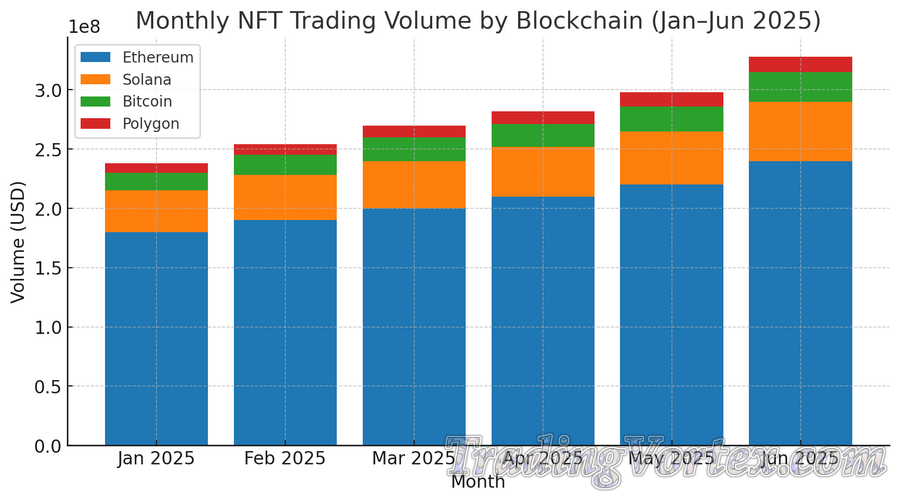 Monthly NFT Trading Volume by Blockchain (Jan–Jun 2025): Shows trading volume distribution across Ethereum, Solana, Bitcoin, and Polygon. Useful for spotting liquidity trends and chain rotation opportunities.
Monthly NFT Trading Volume by Blockchain (Jan–Jun 2025): Shows trading volume distribution across Ethereum, Solana, Bitcoin, and Polygon. Useful for spotting liquidity trends and chain rotation opportunities.
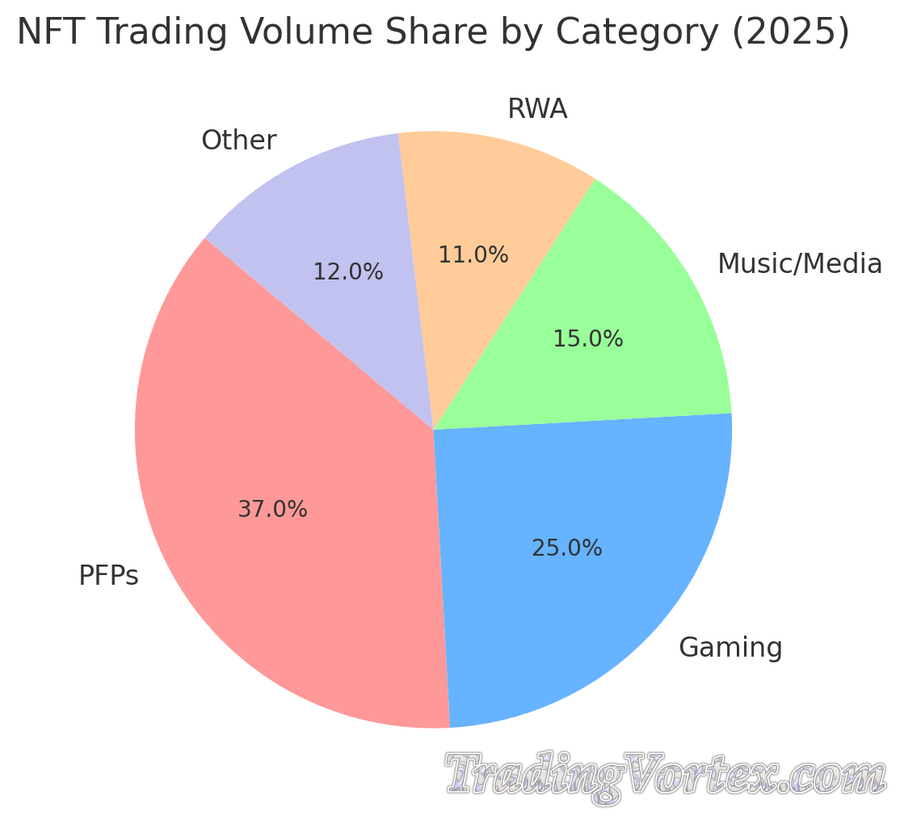 NFT Trading Volume Share by Category (2025): Highlights the share of PFPs, Gaming, Music/Media, Real World Assets, and Other categories. Helps you identify which verticals to target for flips.
NFT Trading Volume Share by Category (2025): Highlights the share of PFPs, Gaming, Music/Media, Real World Assets, and Other categories. Helps you identify which verticals to target for flips.
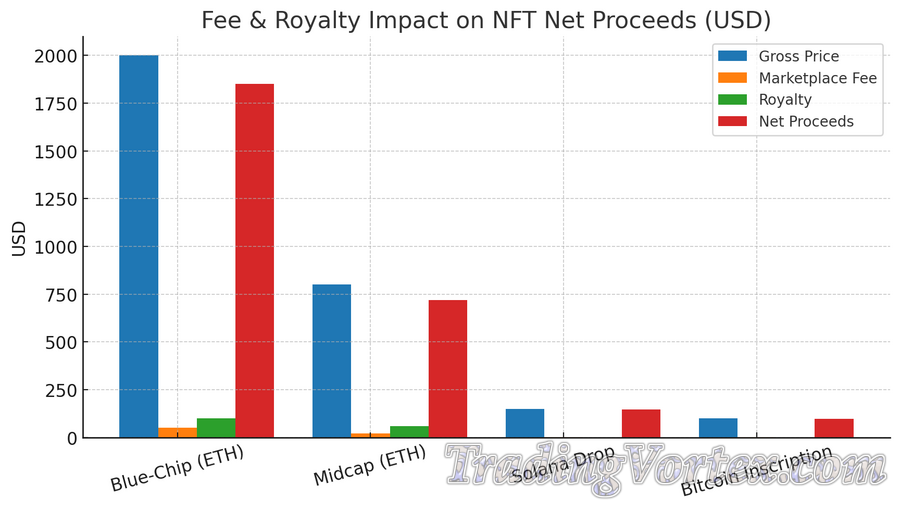 Fee & Royalty Impact on Net Proceeds (USD): Compares gross price, marketplace fees, royalties, and net proceeds for different NFT types, essential for planning margins and expected take-home profits.
Fee & Royalty Impact on Net Proceeds (USD): Compares gross price, marketplace fees, royalties, and net proceeds for different NFT types, essential for planning margins and expected take-home profits.
Best NFT Marketplaces and Tools for Beginners:
Stepping into the NFT flipping world in 2025 can feel like entering a bustling digital bazaar where every booth promises hidden treasures. The truth is, the right marketplaces and tools can save you time, money, and headaches while helping you spot genuine opportunities. In this section, we break down everything you need to know to get started, from the most popular marketplaces to analytics platforms, wallets, and portfolio tracking tools.
Top NFT Marketplaces in 2025:
Choosing the right marketplace is more than picking a platform with the most listings. You want liquidity, security, low fees, and features that match your flipping strategy. Here are the platforms that matter the most in 2025:
- 1. Blur: Blur has quickly become a favorite for traders who want real-time market insights. It is designed with active flippers in mind, offering bulk listing options, rapid floor price updates, and an interface built for speed. If you like to move fast and capitalize on trends, Blur gives you the edge. The platform is also known for integrating analytics directly into the marketplace, which means you spend less time toggling between different apps.
- 2. OpenSea: OpenSea remains the largest and most recognized NFT marketplace globally. Its sheer size means it hosts a wide range of collections, from beginner-friendly drops to high-value blue-chip NFTs. OpenSea has refined its user interface to make browsing, filtering, and tracking collections easier for newcomers. It also provides educational resources to help you understand royalties, fees, and smart contract details, which is crucial when calculating net profits.
- 3. Magic Eden: Magic Eden started on Solana but now supports multiple blockchains, making it an excellent choice for cross-chain flippers. The platform is known for low fees, fast transaction processing, and a robust ecosystem for gaming and collectibles. Magic Eden’s incentive programs, like Diamonds, reward active traders, which can increase your potential upside if you engage strategically.
- 4. Tensor: Tensor has gained a strong following for its AI-powered insights and advanced trading tools. If you like to base your trades on data rather than guesswork, Tensor can help you track rare traits, listing velocities, and shifts in floor prices across multiple collections. Its interface allows you to identify opportunities that might go unnoticed by casual traders.
- 5. OKX NFT: OKX NFT benefits from its integration with the broader OKX exchange ecosystem, which makes transferring funds and managing trades seamless. The marketplace offers a variety of collections and supports multiple blockchains, making it versatile for beginners looking to experiment with different NFT types. OKX also provides analytics and community tools to help you understand collection dynamics before committing capital.
NFT Analytics Tools and Data Platforms:
Data is your friend in NFT flipping. The more you understand the market, the better your decisions will be. Here are the essential analytics tools every beginner should explore:
- Nansen: Tracks on-chain activity and labels wallets to show what professional traders and collectors are doing. This is invaluable for spotting where smart money is moving and identifying trends early.
- NFTGo: Offers real-time insights into collection metrics such as trading volume, floor prices, holder distribution, and rarity. It also allows you to compare collections, which can help prioritize where to focus your attention.
- Dune Analytics: Lets you create custom dashboards to analyze any blockchain data. If you enjoy digging into numbers and spotting unique patterns, Dune allows you to visualize metrics that aren’t readily available on standard marketplaces.
Using these tools helps you make informed decisions rather than relying on hype, and they can also help you avoid crowded trades that have little upside.
Wallets and Security Tools Every Trader Should Use:
Your NFTs are only as safe as your wallet. Beginners often overlook this, but security should always come first:
- Ledger Nano X: A hardware wallet that stores your private keys offline. It is highly secure and supports multiple cryptocurrencies and NFTs.
- Trezor Model One: Another reliable hardware wallet known for durability and strong encryption.
- MetaMask: A browser extension wallet that allows easy interaction with decentralized apps. It is beginner-friendly and widely supported across NFT marketplaces.
- Trust Wallet and Zengo: Mobile wallets that combine user-friendliness with solid security. They are great if you need to manage assets on the go.
Security tips: always verify the smart contract address of collections, avoid clicking on suspicious links, and consider setting up multiple wallets for different chains to minimize risk.
Portfolio, Profit Tracking, and Tax Tools:
Flipping NFTs is fun, but it can get complicated if you do not track your trades and calculate taxes. Here are some tools that make it manageable:
- CoinTracker: Automatically syncs with wallets and exchanges to track your NFT transactions, calculate capital gains, and generate tax reports.
- CoinLedger: Similar to CoinTracker, it integrates with multiple exchanges and wallets, providing portfolio insights and tax-ready reports.
- TaxBit: Specializes in crypto and NFT tax reporting, simplifying the compliance process, especially if you flip across multiple blockchains.
Pro tip: keep a detailed log of minting costs, listing prices, gas fees, royalties, and sale proceeds. Over time, this will help you analyze which strategies are most profitable and give you peace of mind during tax season.
How to Combine Marketplaces and Tools for Maximum Edge:
Here is a simple approach for beginners:
- Pick one or two marketplaces to start with and explore them deeply rather than spreading yourself too thin.
- Use analytics tools to identify collections with active floor movements and strong buyer engagement.
- Store your NFTs in secure wallets and track every trade in a portfolio tool.
- Monitor fees, rewards, and incentives to ensure you understand net profits for each flip.
- Review your trades weekly, adjust your watchlists, and gradually expand to other chains and marketplaces as you gain confidence.
Final Thoughts:
NFT flipping in 2025 is no longer just about spotting a pretty JPEG and hoping for the best. The combination of robust marketplaces, analytics tools, secure wallets, and tax solutions can make the difference between repeated wins and constant frustration.
Start small, focus on learning, and let data guide your decisions. Over time, these tools will become second nature, and you will begin to see opportunities others miss.
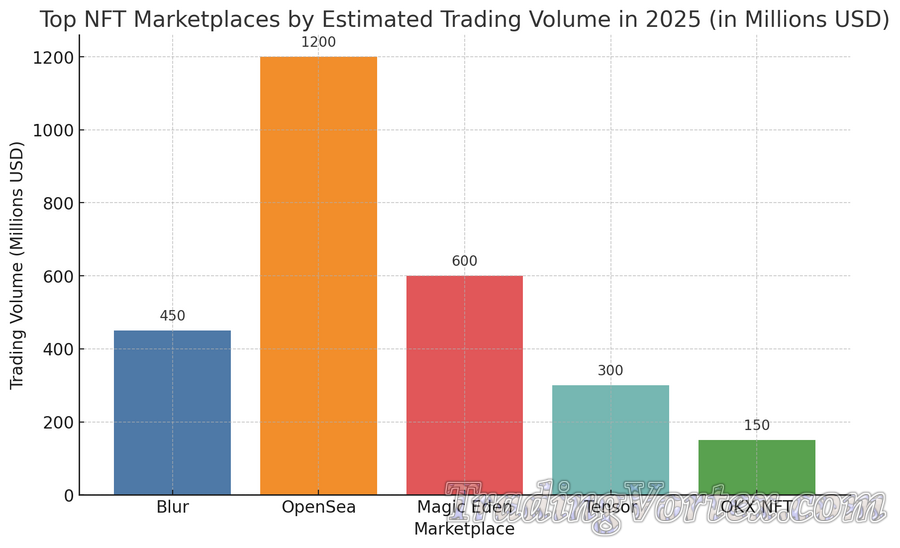 The Estimated Trading Volume for Top NFT Marketplaces in 2025: This chart helps beginners see which marketplaces are currently the most active and can guide where to focus their flipping efforts depending on their strategy and ticket size.
The Estimated Trading Volume for Top NFT Marketplaces in 2025: This chart helps beginners see which marketplaces are currently the most active and can guide where to focus their flipping efforts depending on their strategy and ticket size.
♦ OpenSea leads with the highest volume, reflecting its dominance in blue-chip collections and its large user base.
♦ Blur is gaining traction with active traders, offering tools like bulk listings and real-time floor tracking.
♦ Magic Eden benefits from Solana and cross-chain adoption, supporting micro-ticket flips and gaming NFTs.
♦ Tensor is smaller but growing among data-driven traders seeking analytics insights.
♦ OKX NFT has lower volume but provides integration with the broader exchange ecosystem, appealing to users already in the OKX network.
Proven NFT Flipping Strategies for Beginners in 2025:
NFT flipping in 2025 is no longer just a gamble on pretty images. The market has matured, and while hype still plays a role, data-driven strategies and informed decision-making now dominate profitable flips. For beginners, having a set of proven approaches can make the difference between small wins and costly mistakes. Below, we explore the most effective strategies, explain how they work, and share practical tips to help you get started confidently.
Mint-to-Flip Strategy – Free Mints, Allowlists, and Gas Management:
Mint-to-flip remains a classic entry point for beginners because it allows you to acquire NFTs at minimal cost, sometimes for free. Free mints and allowlist spots are goldmines if you can identify the right projects early. The key is to focus on projects with strong communities, transparent roadmaps, and unique utility or cultural appeal.
Practical Tips:
- Do your homework: Analyze the team behind the project, previous launches, and social media activity to gauge legitimacy and hype potential.
- Manage gas fees smartly: Minting during peak network congestion can inflate costs, so consider timing your transactions for off-peak hours or using Layer 2 solutions when possible.
- Diversify mints: Secure multiple NFTs across different projects or variations within a collection to increase your chances of holding a rare or high-demand piece.
- Join communities early: Discord, Twitter, and Telegram channels often provide insider announcements about allowlists, free mints, or pre-sale opportunities.
Mint-to-flip is low-risk when approached carefully, but remember, not every free mint turns a profit. Patience and selection are your friends here.
Secondary Market Strategies – Floor Bids, Trait Sniping, and Collection Offers:
Once NFTs hit the secondary market, the landscape changes: prices fluctuate, collectors compete, and opportunity windows can be short. Floor bidding, trait sniping, and collection offers are essential strategies for capitalizing on these dynamics.
Practical Tips:
- Floor bidding: Target NFTs priced at the lowest listed values in a collection. Monitor floor trends using analytics tools to ensure you buy near temporary dips rather than permanent lows.
- Trait sniping: Focus on high-demand attributes or rare traits within collections. Some traits can command significant premiums, so familiarity with rarity charts and collection trends is critical.
- Collection offers: Platforms often allow bulk offers to entire collections. This can secure undervalued NFTs and may provide leverage for future flips.
- Monitor buyer behavior: Track which traits or combinations attract collectors most frequently, and adjust your flips accordingly.
Secondary market flipping requires observation, quick decision-making, and an understanding of demand drivers for each collection.
Event-Driven Trading – Partnerships, News, and Airdrops:
NFT prices can spike or dip dramatically in response to external events. Strategic traders leverage announcements of partnerships, collaborations, airdrops, or high-profile endorsements to make timely moves.
Practical Tips:
- Stay informed: Follow official channels, industry news sites, and influencer announcements to spot potential catalysts.
- Evaluate credibility: Not every announcement translates to market movement; focus on news from verified sources or significant partnerships.
- React quickly but wisely: Prices can move fast; set up alerts and watchlists, but avoid panic buying during temporary hype.
- Look for long-term impact: Some events create short-lived spikes, while others drive sustained interest. Recognize the difference to optimize flip timing.
Event-driven trading can be highly profitable if combined with research and swift execution, but it carries higher volatility than other strategies.
Chain Rotation and Seasonal NFT Market Trends:
NFT activity is often cyclical and moves between blockchains. Ethereum, Solana, Polygon, and emerging chains like Base or Ronin each have peak periods of activity. Recognizing these rotations and seasonal trends can give beginners an edge.
Practical Tips:
- Analyze historical trends: Review previous cycles and seasonal patterns to anticipate active periods for each chain.
- Track liquidity shifts: Use data dashboards to see where buyer activity is concentrated.
- Diversify across chains: Spreading your activity can reduce risk and increase opportunities for profitable flips.
- Adjust strategy seasonally: Certain niches, like gaming NFTs or event-based collectibles, often peak during specific months or events.
Chain rotation and seasonal awareness allow you to allocate capital where liquidity and demand are strongest, maximizing your chances for quick flips.
Reward Programs and Liquidity Mining – Points, Diamonds, and Seasons:
Many NFT marketplaces offer incentives beyond the NFTs themselves, rewarding active traders with points, diamonds, or participation in seasonal programs. These rewards can effectively reduce costs, enhance profits, or unlock exclusive opportunities.
Practical Tips:
- Engage consistently: Rewards usually accumulate with trade volume or participation, so consistent activity increases your upside.
- Understand program rules: Each marketplace has unique reward structures; familiarize yourself with redemption processes and eligibility.
- Leverage rewards: Points or diamonds can sometimes be converted into NFTs, discounts, or exclusive access, enhancing overall profitability.
- Track opportunity windows: Seasonal or time-limited programs can create spikes in liquidity and demand that are perfect for flips.
Integrating rewards into your flipping strategy can provide extra returns, especially for active beginners looking to compound their profits over time.
Using NFT Lending and Leverage Safely:
NFT lending has opened new possibilities for traders who want liquidity without selling assets. By borrowing against NFT holdings, you can finance additional flips or access capital for larger opportunities.
Practical Tips:
- Understand the risks: Leverage magnifies both gains and losses; only allocate amounts you are comfortable risking.
- Monitor collateral value: Keep track of market fluctuations to prevent forced liquidations.
- Use reputable platforms: Stick to established lending protocols with transparent terms and security audits.
- Start small: Beginners should experiment with small amounts until comfortable with mechanics and repayment schedules.
Leverage is a powerful tool, but discipline and risk management are essential to avoid costly mistakes.
Final Thoughts:
NFT flipping in 2025 is about strategy, awareness, and adaptability. Beginners who take the time to understand mint opportunities, secondary market mechanics, event-driven catalysts, chain dynamics, reward programs, and lending possibilities will position themselves for consistent, measured success. The key is to combine research, patience, and data-driven decisions with an understanding of your own risk tolerance.
Start small, document every trade, track your successes and mistakes, and gradually scale as your confidence grows. With these proven strategies, flipping NFTs in 2025 becomes not just an exciting endeavor, but a structured, profitable activity.
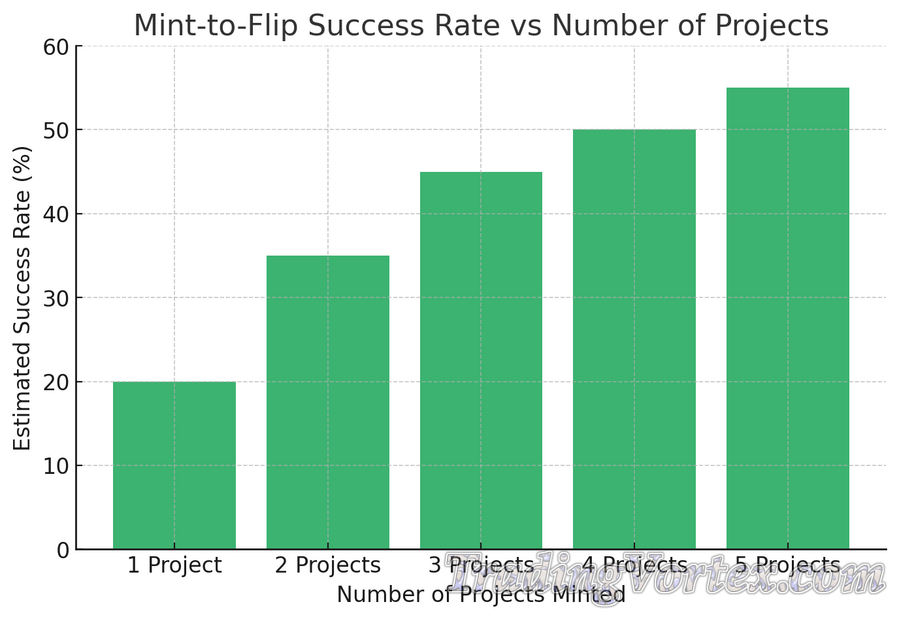 Mint-to-Flip Success Rate vs Number of Projects: This chart shows how your chance of a profitable mint-to-flip increases as you participate in more projects. Beginners can use this insight to diversify their mints, balancing risk across multiple drops rather than relying on a single project. For example, minting 3–4 projects can raise your estimated success rate to around 45–50%.
Mint-to-Flip Success Rate vs Number of Projects: This chart shows how your chance of a profitable mint-to-flip increases as you participate in more projects. Beginners can use this insight to diversify their mints, balancing risk across multiple drops rather than relying on a single project. For example, minting 3–4 projects can raise your estimated success rate to around 45–50%.
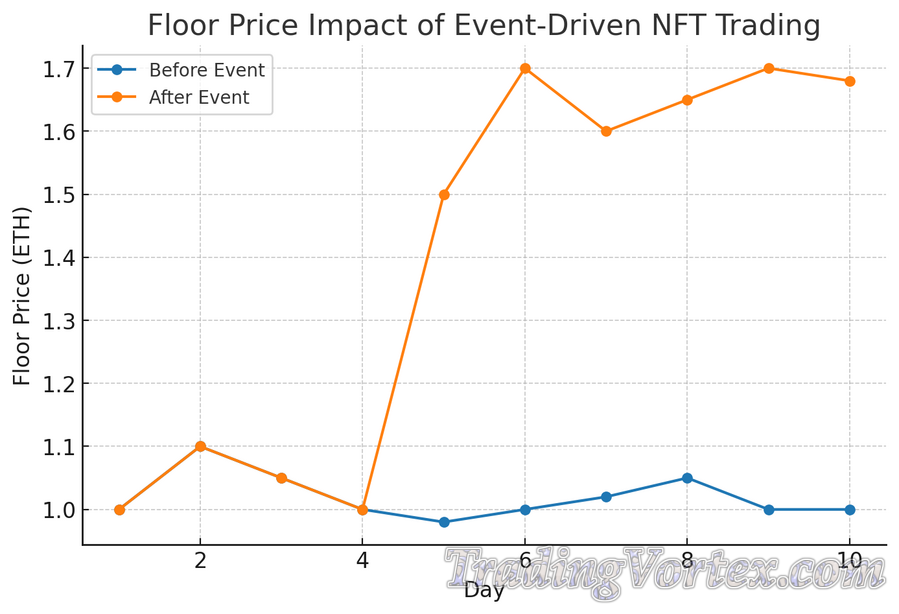 Floor Price Impact of Event-Driven NFT Trading: This line chart illustrates how an NFT's floor price can react to an external event such as a partnership announcement or airdrop. Notice the spike after day 5, showing a sudden price increase. Beginners should monitor news and announcements closely, as acting quickly after positive events can allow them to buy low before hype pushes prices up further.
Floor Price Impact of Event-Driven NFT Trading: This line chart illustrates how an NFT's floor price can react to an external event such as a partnership announcement or airdrop. Notice the spike after day 5, showing a sudden price increase. Beginners should monitor news and announcements closely, as acting quickly after positive events can allow them to buy low before hype pushes prices up further.
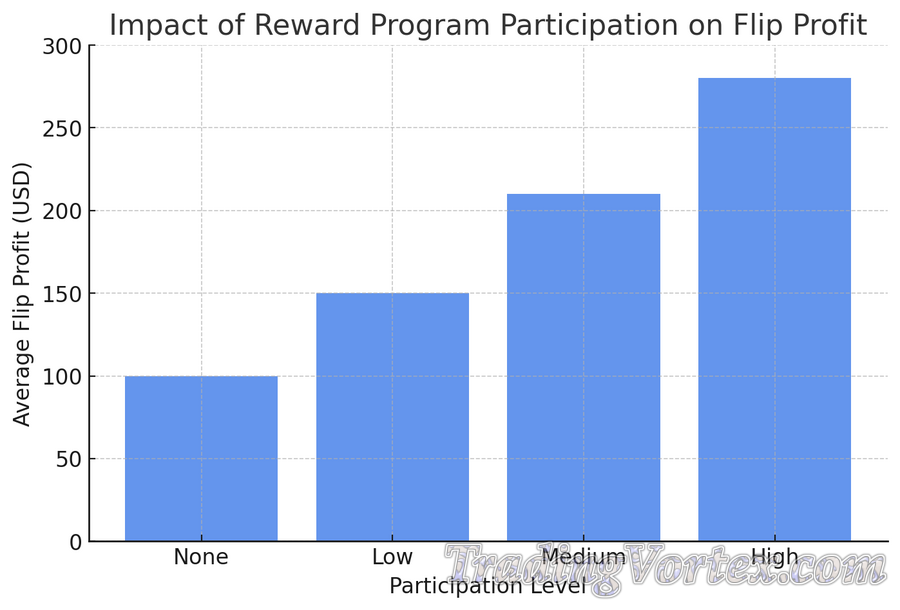 Impact of Reward Program Participation on Flip Profit: This bar chart demonstrates the correlation between participation in marketplace reward programs and average flip profit. Engaging more actively in points, diamonds, or seasonal programs can significantly boost profitability. Beginners can prioritize marketplaces that offer these rewards and track their participation to maximize net gains.
Impact of Reward Program Participation on Flip Profit: This bar chart demonstrates the correlation between participation in marketplace reward programs and average flip profit. Engaging more actively in points, diamonds, or seasonal programs can significantly boost profitability. Beginners can prioritize marketplaces that offer these rewards and track their participation to maximize net gains.
Risk Management for Successful NFT Flipping:
If you treat NFT flipping like a casino, the house usually wins. If you treat it like a trading business, with rules, logs, and limits, you give yourself a real shot. Below is a practical playbook I share with friends who trade across chains. It mixes fresh data with hard-earned habits and keeps the tone straight, friendly, and actionable.
Bankroll Management and Position Sizing:
- Cap your exposure per trade: Pick a fixed risk unit, for example 1 to 2% of your total bankroll per entry. If your roll is $5,000, you risk at most $50 to $100 on any single idea. That keeps one bad reveal, one bad tweet, or one surprise delist from wrecking you.
- Use a tiered approach: Split entries, for example 70% near floor, 30% reserved for trait or momentum buys. Average in only if liquidity and catalysts support it.
- Portfolio guardrails: Set a max share per collection, for example no more than 10 to 15% of bankroll in one project, and a chain cap, for example no more than 50% on a single chain.
- Cash buffer: Hold 20 to 30% in stablecoins for gas, fast rotations, and emergencies. Markets can get busy when you least expect it, and you will want dry powder.
- Reality check from the tape: 2025 has seen choppy liquidity. Sales counts spiked in Q2 while total dollar volume softened, a sign of many small trades and thinner depth. In those conditions, smaller position sizes and faster rotations reduce stress.
How to Avoid Liquidity Traps and Wash Trading:
- Check for genuine participation: Look at unique buyers versus sellers, not just sales count. If buys come from a handful of wallets and trades ping-pong at the floor, be cautious. CryptoSlam and similar dashboards show sales, unique buyers, and even wash-trade flags.
- Beware incentive farming: Rewards, points, and seasons can inflate volumes without sticky demand. Treat sudden spikes around rewards windows as potential exit liquidity for someone else. Magic Eden’s rewards programs are public, useful, and can move behavior, so know the schedule before you chase.
- Read the chart like a market, not a museum: If time-to-sell stretches beyond 24 to 72 hours on common traits, that is a trap forming. Thin books mean you can enter easily and exit painfully.
- Use on-chain tells: Rapid back-and-forth between the same wallets, round-number listings that reset often, or volume that vanishes after a snapshot, all suggest wash trading or farm activity. Chainalysis estimates suspected wash trading on select chains reached into the billions in 2025, so assume it exists and filter for it.
- Trade where you understand the rules: Some marketplaces show collection-wide bids that look deep, then disappear after an airdrop snapshot. If you do not know why the bid is there, pass.
Understanding Marketplace Fees, Gas Costs, and Royalties:
Your true profit is sale price minus marketplace fee, minus royalty, minus gas, minus slippage.
- Marketplace fees vary:
- OpenSea lists a seller fee in the low single digits on secondaries in 2025, with creator earnings set by collection owners. Check the current fee page before you list.
- Blur has historically run with 0% marketplace fees and minimal enforced royalties, though proposals have discussed adding a protocol fee. Policies can shift, so confirm before you trade.
- Royalties are often optional: The industry moved away from strict royalty enforcement on many venues. Treat royalties as a variable cost that can change with venue and contract type.
- Gas planning by chain:
- Ethereum L1: Higher and spiky. Great for blue chips and high value flips, less ideal for rapid scalps.
- Layer 2s after Dencun: EIP-4844 cut data costs for L2s, which helped lower transaction fees significantly. Good for active listing, relisting, and sweeping.
- Solana: Cheap fees and fast finality, though periodic congestion events have happened. Plan for retries during hot mints.
- Front-running risk: On public mempools, bots can jump your trade by paying more gas. Avoid obvious sandwich targets and use protected transaction relays when available.
Practical calculator: Before buying, write the breakeven price you need after fees and royalties. If your breakeven requires a heroic move, do not take it. Simple rule, many headaches avoided.
Creating an Exit Plan and Trade Journal:
- Decide exits at entry: If you buy at 1.00, plan a base case exit, for example 1.20 to 1.30 within a week, a stretch exit, for example 1.50 on a catalyst, and a stop, for example 0.85 on invalidation. Put the numbers in your listing tool immediately, not “later”.
- Catalyst calendar: Write down upcoming triggers, for example game launch dates, trait reveals, partnership AMAs, or reward snapshots. If the catalyst slips or underdelivers, take the loss quickly.
- Journal like a pro: Track date, chain, collection, trait, thesis, fees, gas, exit reason, and PnL. Note whether the edge came from information, timing, or luck. Over 20 to 30 trades you will spot your real strengths.
- Weekly review ritual: On Sundays, close weak listings, consolidate to liquid traits, and move idle capital to chains with better flow. This keeps you nimble when the market rotates.
- Psychology guardrails: If you feel FOMO, reduce size by half. If you feel revengey after a loss, pause. Your worst trades rarely come from your best mood.
Quick Checklist Before Every Flip:
- Does this collection have real buyers today, not just yesterday?
- Do I know the exact total cost to round trip this trade, fees included?
- What is my pre-set stop and target, and is the listing already set?
- Is there a near-term catalyst that can help, or a rewards event that can distort?
- If liquidity dries up, can I exit without nuking 5 to 10% of the floor?
Keep it boring behind the scenes, so the results can be exciting. The 2025 market rewards discipline, not drama. Data confirms a market that trades often yet with uneven depth, so play small, play planned, and let compounding do the heavy lifting.
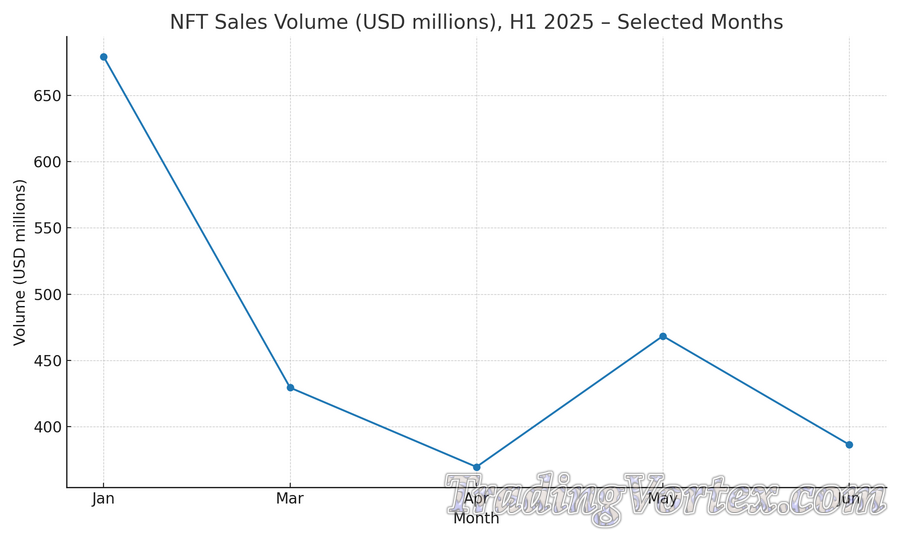 NFT sales volume in H1 2025, selected months:
NFT sales volume in H1 2025, selected months:
What you are seeing: monthly sales volume for January, then March through June 2025. January was the local peak, then the market cooled into Q2.
How to use it: in softer months, tighten risk, shorten hold times, and avoid illiquid mints. Stronger months tolerate wider stops and longer holds. Data for Jan, plus Q1 vs Q2 totals, comes from a July 10, 2025 synthesis of CryptoSlam and DappRadar figures; March to June monthly values mirror CryptoSlam’s monthly board.
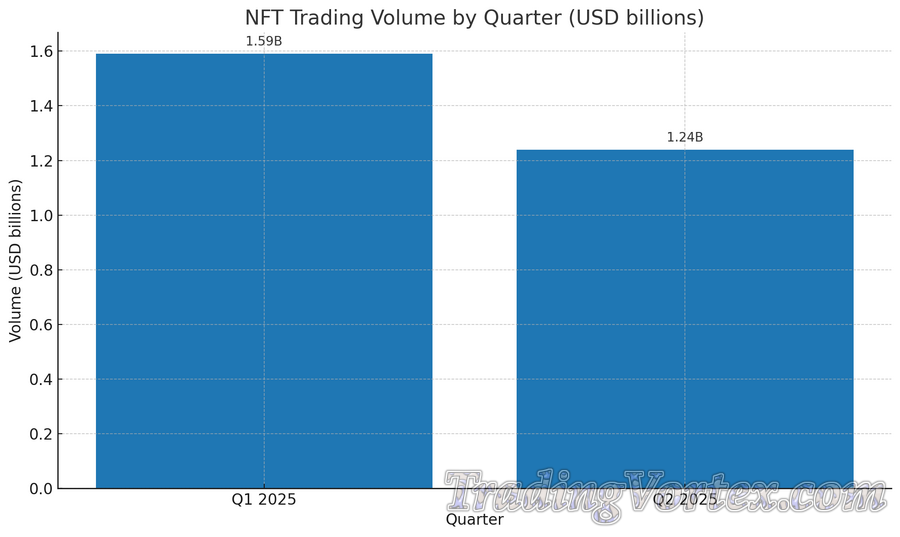 Trading volume by quarter, Q1 vs Q2 2025:
Trading volume by quarter, Q1 vs Q2 2025:
What you are seeing: total USD volume fell from about $1.59B in Q1 to $1.24B in Q2.
How to use it: lower dollar volume usually means thinner books and faster slippage, so reduce position sizes and bid closer to floor in Q2-style conditions.
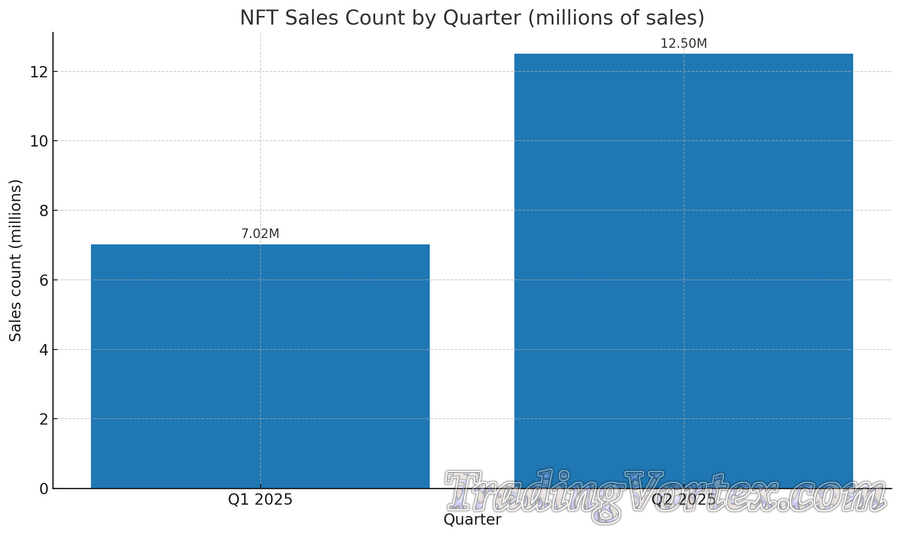 Sales count by quarter, Q1 vs Q2 2025:
Sales count by quarter, Q1 vs Q2 2025:
What you are seeing: sales count jumped to ~12.5M in Q2, up about 78% versus Q1. We back-calculated Q1 at ~7.0M sales.
How to use it: more transactions with less total volume means smaller ticket sizes, more scalping, and more churn. Plan for quicker flips, stricter profit targets, and avoid chasing rare traits into thin order books.
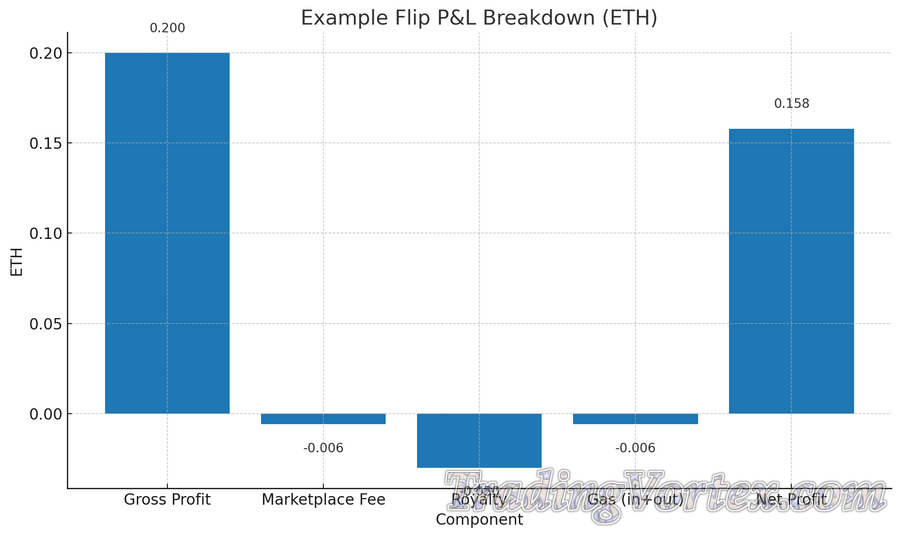 Flip P&L breakdown, OpenSea fee example:
Flip P&L breakdown, OpenSea fee example:
What you are seeing: a sample 1.00 ETH buy, 1.20 ETH sell, with OpenSea’s 0.5% marketplace fee, a 2.5% creator royalty example, and modest gas on entry and exit. Net profit lands well below the raw 0.20 ETH spread.
How to use it: before bidding, write down your expected fee stack and gas; if your net falls under your minimum ROI, skip the trade. OpenSea’s 0.5% sell fee is documented in their help center. Adjust royalty and gas to match the specific collection and chain you trade.
NFT Security and Wallet Safety in 2025:
Below is the security stack I actually use and recommend to friends who trade NFTs at all levels:
Hot vs cold wallets – build a simple, safe setup:
Hot wallets live on connected devices, great for minting, bidding, and quick flips. Cold wallets keep keys offline on hardware, ideal for vaulting high-value NFTs and stables. Use both, with clear roles:
- Vault wallet, hardware secured: store grails and idle funds. Only connect when absolutely necessary, and only to verified sites. Hardware devices reduce online key exposure, and modern firmware supports clearer signing so you can see what you are approving before you click confirm.
- Trading wallet, low balance: do all day-to-day activity here. Fund it per session, then sweep profits back to the vault when done.
- Disposable “burner” wallets: for risky mints, unfamiliar dapps, and tests. Burners help contain damage if a site is malicious.
Pro tip: if your hardware supports passphrases and advanced backups, learn them, then practice a full recovery before you store anything valuable. It feels tedious, and it can literally save your collection.
Why bother with this separation? Because losses remain significant industry-wide, and many start with a single sloppy click in a hot wallet that held everything. Social engineering and phishing continue to drive a large share of crypto crime in 2025, so compartmentalizing risk matters.
Secure signing – know what you are approving, every time:
Most drains do not look like “Send all my NFTs to attacker.” They hide inside approvals, listings, or off-chain signatures. A few rules that make a huge difference:
- Slow down on signature popups. Read human-readable previews and look for red flags, like unlimited approvals, Seaport orders you did not create, or Permit-style signatures that allow spending without another on-chain transaction. MetaMask’s guidance is clear, and 2025 wallet updates continue to warn users about risky sign types.
- Prefer wallets and extensions with simulation. If your wallet shows exactly what will move before you sign, use it. Phantom displays warnings on risky actions and lets you manage connections, which helps prevent casual drains, especially on Solana.
- Turn off blind signing on hardware if possible. Clear, structured signing makes intent visible and reduces “sign first, regret later” scenarios. Ledger’s materials emphasize avoiding blind signing and moving to clear signing wherever supported.
Revoke old approvals, clean up connections, reduce blast radius:
Think of approvals as open tabs on your funds. If you are not using a dapp anymore, close the tab.
- On EVM chains: use Revoke.cash to find and remove stale ERC-20, ERC-721, and ERC-1155 allowances, or the Etherscan Token Approval tool to review per-contract access. Revoke sessions that no longer serve you.
- On Solana and other chains: follow your wallet’s “connected apps” manager, and use chain-specific revoke flows. Magic Eden’s 2025 guides walk through revoking approvals across Ethereum, Base, Polygon, and Solana, plus why periodic reviews matter.
Make this a habit: calendar a five-minute “approval cleanup” after any busy trading week.
Phishing, scams, and social engineering – the current playbook:
Attackers lean on urgency, impersonation, and hijacked accounts. Common lures include fake airdrops, support DMs, “urgent security updates,” and too-good-to-be-true mints.
- Verify links, then verify them again. Bookmark official sites and marketplace pages. OpenSea’s safety guides remain simple and useful: never share seed phrases, never trust attachments, and double-check URLs.
- Watch for fake airdrops and inbox bait. Magic Eden documents the “mystery box” airdrop scam, a classic tactic to get you to click and sign. Treat surprise tokens as hostile until proven otherwise.
- Assume social feeds can be compromised. Cross-check announcements across multiple official channels before you connect or mint. Crypto crime data continues to show scammers adapting social tactics quickly, which means your skepticism pays the bills.
Step-by-step secure minting checklist:
Use this when minting or connecting to a new project. It is boring, and it works:
- Scope and split: decide the maximum you are willing to lose on this mint, then fund a burner wallet with only that amount. Keep your vault and trading wallets out of it.
- Find the source: get the mint link from two official channels, for example the project website and an announcement channel, not from replies or DMs. Cross-check the contract address if possible. Marketplaces and wallet providers publish safety basics for a reason.
- Pre-mint checks: update your wallet, enable any built-in security alerts, and ensure hardware firmware is current. If your wallet offers simulation, keep it on. MetaMask and Phantom provide guidance and warnings around risky signatures and connections.
- Read every prompt: confirm the site URL, confirm the network, and read the signature or transaction summary. Avoid unlimited approvals, especially on stablecoins or wrapped ETH. If you see a Permit or listing you did not expect, cancel.
- Mint small first: if supply and timing allow, mint one unit, confirm it lands, then proceed.
- After the mint: revoke any unnecessary approvals you granted, especially if the site was a one-off. Clean up connected apps.
- Sweep and store: move anything valuable to your vault. Sign out of the burner or archive it.
Extra hygiene that compounds over time:
- Use unique browser profiles for different wallets and trading roles. Compartmentalization helps contain risk. MetaMask’s guidance on multi-wallet setups via browser profiles is a practical starting point.
- Keep marketplace accounts locked down. Use strong passwords and hardware-based 2FA where supported, and treat email security as part of your crypto security, especially given past phishing waves.
- Practice recoveries. Test your seed phrase recovery on a spare device before you need it. Trezor’s passphrase documentation explains how advanced setups work, so you can choose the right balance of security and convenience.
Bottom line:
Security is a habit, not a product. Pair a hardware vault with low-balance trading and burner wallets, read every signature like money is on the line, and make revokes a weekly ritual. The goal is not perfection, the goal is resilience. A few small habits will keep you active, confident, and ready for the next opportunity without fearing every click.
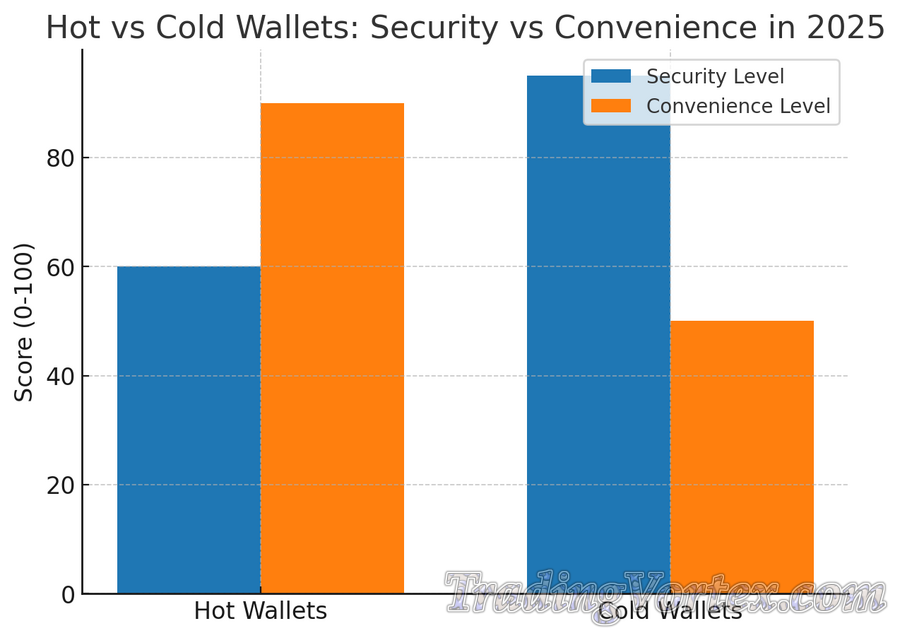 Hot vs Cold Wallets in 2025 – Convenience in 2025: a clear comparison chart showing Hot vs Cold Wallets in 2025. It illustrates that hot wallets are more convenient but less secure, while cold wallets are highly secure but less convenient. This visual helps readers quickly grasp why many NFT traders use both a hot wallet for quick trades and a cold wallet for long-term safe storage.
Hot vs Cold Wallets in 2025 – Convenience in 2025: a clear comparison chart showing Hot vs Cold Wallets in 2025. It illustrates that hot wallets are more convenient but less secure, while cold wallets are highly secure but less convenient. This visual helps readers quickly grasp why many NFT traders use both a hot wallet for quick trades and a cold wallet for long-term safe storage.
How to Research and Evaluate NFT Projects:
Doing good research is the difference between a lucky flip and a repeatable trading system. This section gives you a practical, step-by-step due diligence playbook you can run through in 10–30 minutes before you commit capital, plus the deeper checks to use when you plan to hold or size up a bigger position.
Read it like advice from a trading buddy who has lost a few trades, learned the hard way, and now wants you to avoid the same facepalm moments.
Quick first-pass checklist (10 minutes):
- Is the team visible and verifiable?
- Are there real backers or reputable partners listed?
- Is the smart contract verified on-chain?
- Where is the media and metadata stored, and is it pinned?
- What is the supply, mint price, and royalty setup?
- Does the roadmap include real utility or just buzz?
If any one of these answers looks and feels shady, pause and dig deeper.
Checking the team, backers, and community strength:
What to do:
- Look up the team on LinkedIn and GitHub, confirm past projects, and check whether core members’ profiles are more than new accounts with little history.
- Search for real backers: VC logos on a site are useful only if the firm actually lists the project on its portfolio pages; cross-check press releases and partner announcements. Messari and similar research hubs make it easier to see funding and fundraising context for Web3 projects.
- Gauge community signals: join the project Discord and scan the pinned channels, recent activity, moderator transparency, and AMA logs; look for spammy invite bots, mass giveaways, or private channels that hide key info.
- Track smart money and institutional participation with analytics platforms that label wallets and addresses; seeing a few recognized collector or institutional wallets buying in early is a positive signal, but it is not a guarantee. Nansen’s smart money workflows and labeling are widely used for this purpose.
Red flags: anonymous team that refuses to verify identity, press releases that link to dead pages, community chats full of bots and pump talk, or “partners” that are only logos with no linked proof.
Smart contracts, audits, metadata, and storage reliability:
What to check:
- Contract verification: confirm the collection’s contract is verified on-chain, for example on Etherscan for Ethereum-based projects; verified source code lets you read the implementation, confirm mint rules and royalty logic, and spot obvious backdoors. Etherscan and similar explorers document contract verification and are the canonical place to confirm this.
- Audit reports: look for third-party audit reports from reputable firms such as CertiK, Hacken, or others; audits do not remove all risk, but they reduce the odds of obvious contract bugs and provide a public report you can review.
- Metadata and media storage: verify where the JSON metadata and media files are hosted. On-chain metadata is the most durable; off-chain metadata should at least use decentralized pinning to IPFS, or permanent storage like Arweave, and reputable projects will note pinning strategies or provide Arweave transaction IDs. Using IPFS without pinning can mean content is not persistently available, so look for pinning services or Arweave receipts.
- Dynamic features and token-bound accounts: if the project claims on-chain composability or token-bound accounts, confirm the standards used and whether wallets and marketplaces support those standards yet; new standards can be powerful, but they add complexity and compatibility risk.
Red flags: unverifiable or missing contract address on the project site, “contract pending” text, media served only from centralized storage without IPFS/Arweave references, or audit screenshots with broken links.
Supply, mint price, royalty structure, and economics:
How to evaluate:
- Supply math: smaller supply usually means scarcity value but also thinner liquidity; very large supply may require a clear utility to sustain demand. Calculate how many units you need to sell to recover costs, and how that maps to realistic demand.
- Mint price and fee transparency: confirm mint price plus gas or collection fees, so you know your true cost basis. For secondary flips, compute the breakeven price after marketplace fees and royalties. OpenSea and other marketplaces changed royalty enforcement rules in recent years; royalty policies vary by marketplace and contract, so confirm how royalties are enforced where you plan to sell.
- Royalty mechanics: some projects enforce royalties via contract-level mechanisms, others rely on marketplace enforcement, and some marketplaces make royalties optional; enforcement differences materially affect flip margins, so treat royalties as a first-class input in your P&L.
Red flags: hidden fees; projects that shift royalty or distribution terms after mint without clear governance or holder votes; mint incentives that solely rely on points or airdrops with no clear value accrual.
Roadmaps, utility, and long-term sustainability:
What to look for:
- Concrete, time-bound milestones: a roadmap that names partners, launch windows, game alpha dates, or tokenomics milestones is better than vague promises of “community growth.” Check whether earlier milestones were met on past projects from the same team; track record matters. Messari and other research outlets often summarize project progress and tokenomic health for broader context.
- Real utility: utility can be access, game items that are actually used in on-chain gameplay, revenue-sharing mechanics, or tokenized physical goods; the more tangible and verifiable the utility, the better the chance of long-lived demand.
- Sustainability of incentives: be wary of projects that depend solely on reward farming or temporary token airdrops to drive volume; those can create short-lived volume spikes that evaporate once the program ends. Chainalysis and market reports continue to highlight manipulation and wash trading as risks that can be driven by incentive farming, so read program rules carefully.
Red flags: roadmap full of vague marketing milestones, utility promised without technical proof, or a heavy reliance on token incentives with no plan for long-term value capture.
Practical tools and signals to use right now:
- Etherscan / blockchain explorers: verify contracts and read on-chain transactions.
- Nansen and similar analytics: track smart money, labeled wallets, and on-chain flows.
- Dune Analytics: find or build dashboards that track holder concentration, volume, and mint distribution.
- IPFS / Arweave checks: confirm metadata URIs and pinning, or check Arweave transaction IDs.
- Audit reports: search for public audit PDF and read the summary of findings; reputable auditors publish clear reports.
Final practical checklist you can paste into your workflow:
- Confirm contract address, verify on Etherscan or equivalent.
- Find any third-party audits, read the executive summary.
- Verify metadata URIs point to IPFS or Arweave, and check for pinning or proof of permanence.
- Confirm supply math, mint cost, and compute breakeven after fees and royalties, account for marketplace policy differences.
- Scan community channels for noise vs real engagement, check team profiles and partner announcements.
- Check smart-money activity, if present, to validate early collector interest.
A quick, honest anecdote:
I once bought into a hype mint because the art was fun and the Twitter buzz felt real. I skipped the contract checks and the project later revealed media hosted on a central server that went offline a month later. The NFT still existed on chain, but its display was gone until the team repinned images; that wiped liquidity and my exit option.
Since then, I always confirm on-chain URIs and pinning before I mint. It is small work that saves many headaches.
Closing note:
Due diligence is not glamorous, but it is where consistent profits begin. Use the checklist above, lean on block explorers, analytics, and audits, and remember that no single signal is proof of success.
You want converging evidence: a verifiable contract, durable metadata, a competent and visible team, reasonable economics, and a community that does more than talk. When those align, you have a project worth sizing into; when they do not, your best call is often to wait for a clearer setup.
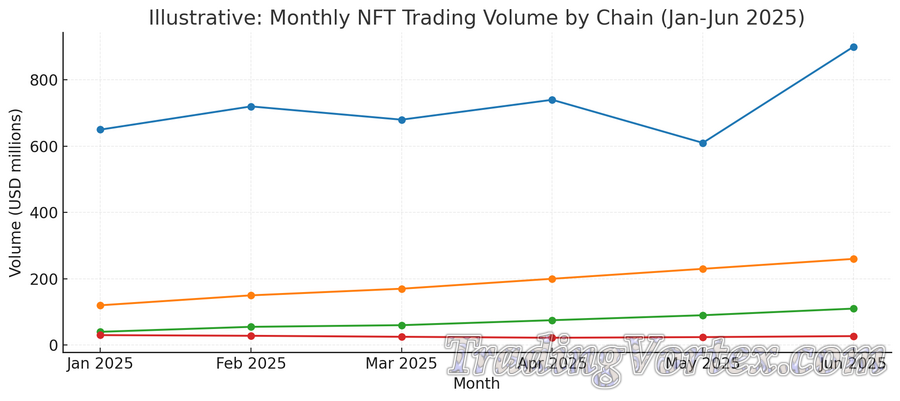 Monthly NFT trading volume by chain:
Monthly NFT trading volume by chain:
♦ What the chart shows: Relative depth by chain, month by month. In the model, Ethereum remains the main liquidity center, Solana grows steadily, Bitcoin inscriptions show rising interest, while other chains stay smaller.
♦ Why it matters to your flips: If a collection lives on a chain with rising volume, you will have a higher chance to find buyers quickly. If volume on the chain is shrinking, expect wider spreads and slower exits.
♦ How to use it: Build a weekly habit: monitor volume trends per chain, then match your flipping style to the chain that has the right balance of fees and liquidity for your ticket size.
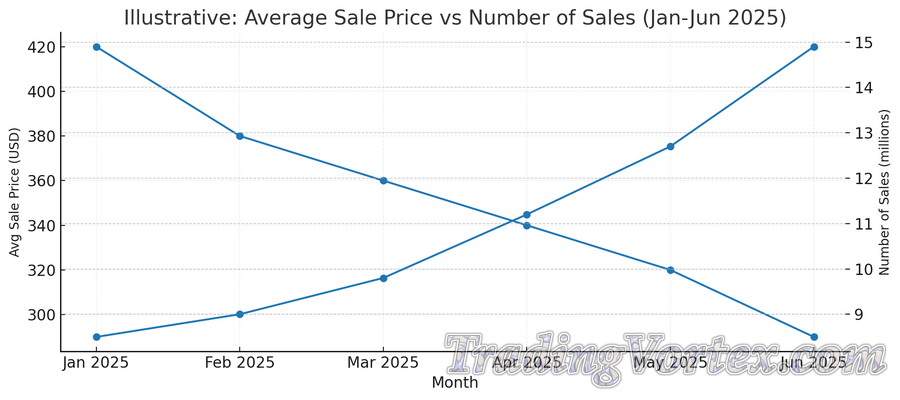 Average sale price vs number of sales:
Average sale price vs number of sales:
♦ What the chart shows: Number of sales grew in the example period, while average sale price trended lower. This means more low-ticket trades, lighter per-item liquidity, and faster rotations instead of big single sales.
♦ Why it matters: More sales but lower average price shift profitable flipping toward high-frequency, small-margin plays rather than occasional large wins.
♦ How to use it: If you see this pattern in a collection you trade, lower your position sizes, tighten stop rules, and favor chains or marketplaces with low fees so micro-flips remain profitable.
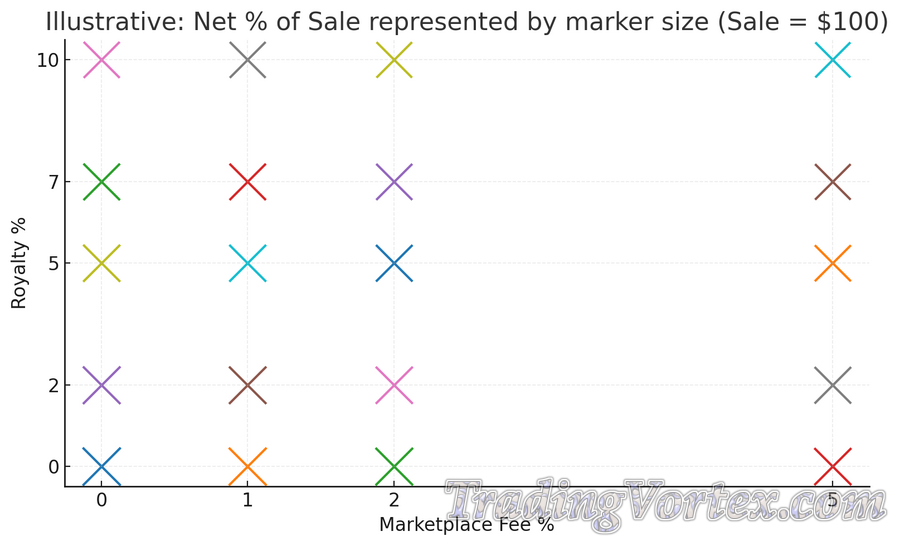 Net proceeds after royalties and marketplace fees (sale = $100):
Net proceeds after royalties and marketplace fees (sale = $100):
♦ What the table and scatter show: Net proceeds are computed for combinations of royalty rates and marketplace fees. Marker sizes approximate the net percent of sale; smaller markers mean less net money to you.
♦ Why it matters: On a $100 sale, a 10 percent royalty and 5 percent marketplace fee together leave you with only about $85 minus gas and slippage. That can turn a seeming winner into a loss after costs.
♦ How to use it: Always compute a breakeven price before you buy. Use the table as a quick reference: plug in expected royalties and marketplace fees, then add estimated gas and slippage to get a realist breakeven. If your expected sale needs a heroic upside, skip it.
NFT Taxes and Regulations in 2025:
Tax talk is the part of NFT flipping nobody enjoys, until you realize doing it right saves real money and a lot of stress. In 2025 the picture is clearer than it was in 2021, but it is also more regulated: tax authorities want visibility, marketplaces and brokers are starting to report, and cross-border reporting frameworks are rolling out.
Below you will find a practical, region-aware explanation of how NFT activity is treated today, clear rules-of-thumb for traders and creators, and a compact set of record-keeping and compliance steps you can actually use.
Big-picture rules you need in your head first:
- Most tax authorities treat NFTs as taxable property or crypto-like assets, not magic exceptions: that means buying, selling, minting, earning royalties, or receiving airdrops all trigger possible tax events depending on the facts.
- Governments are increasing reporting: international frameworks such as the OECD’s Crypto-Asset Reporting Framework, and regional rules like the EU’s VAT/DAC8 moves, are pushing more transaction-level data into tax authorities’ hands. Expect more automated reporting from marketplaces and brokers.
- Practical takeaway: plan every NFT trade like a small business transaction, keep receipts, record gas and fees, and track timestamps and fiat values. This saves hours during filing season, and keeps surprises to a minimum. (Procedures and tool suggestions appear below.)
How NFT profits are taxed in major jurisdictions:
United States (IRS):
United Kingdom (HMRC):
European Union:
Canada (CRA):
Australia (ATO):
Income vs capital gains: how that actually plays out for flippers and creators?
- Investor / flipper: Most secondary-market sellers are treated as disposing of a capital asset, so sales generate capital gains or losses measured as sale proceeds minus cost basis in local-currency terms. Short-term holding windows mean you often pay ordinary/short-term rates in many countries, or higher short-term marginal rates; long-term holding may qualify for lower long-term rates where the regime provides them. In the US, certain NFTs could be classified as collectibles and taxed at a higher long-term rate, so be careful.
- Creator / artist: If you create and sell NFTs as part of your business or regular activity, revenues are generally ordinary income or business income, not capital gains. That income may be subject to self-employment tax in jurisdictions like the US, and it should be reported on the business or self-employment forms that apply to you. Royalty streams paid over time are typically ordinary income.
- Airdrops and freebies: Many tax authorities treat airdrops as income at the time you receive them, measured at fair market value. If you later sell the asset, any gain or loss is measured versus that income basis. The IRS FAQ and several tax guides emphasize that airdrops are normally taxable events.
- Using crypto to buy NFTs: If you buy an NFT with ETH or another token, you usually trigger a taxable event on the disposal of the token you spent, since using crypto is like selling it for the NFT. That means you must compute gain or loss on the spent crypto at the time of purchase. Keep the crypto transaction record and fiat equivalents.
Regulatory and reporting trends that affect traders:
- More market-level reporting: Expect marketplaces and central custody platforms to supply tax authorities with more granular data in 2025 and beyond, due to CARF/DAC8 and domestic reporting rules; that will make matching easier for tax agencies, so under-reporting is riskier than before.
- Anti-money-laundering tightening: Global AML agencies are pushing for stronger oversight of virtual assets, including NFTs, which means stricter KYC and suspicious activity monitoring by major marketplaces. This affects privacy-sensitive users and emphasizes the need for compliant counterparty selection.
Tools and best practices for record-keeping and compliance:
Tools that save time:
- Tax software: Market leaders for NFT and crypto reporting include CoinTracker, Koinly, TokenTax, TaxBit, CoinLedger; these tools can import exchange, wallet, and marketplace data and produce tax reports and gain/loss statements. Pick one that supports NFT metadata import, and test its CSV exports before filing.
- Analytics & provenance: Use blockchain explorers like Etherscan, and marketplace receipts, to capture contract addresses, token IDs, and transaction hashes. These are essential proofs of ownership dates, costs, and provenance.
Practical record-keeping checklist
Do this for every mint, buy, sale, or income event:
- Save the transaction hash, token ID, and contract address.
- Record the date and the fiat value at that exact timestamp, and note the exchange rate source.
- Log the spend leg: if you spent ETH or other crypto to buy, save the crypto disposal details and cost basis used.
- Save screenshots and a copy of the mint page, the project contract address, and any allowlist or allocation proof.
- Record marketplace fees, network gas, and royalties paid, all in fiat so you can compute net proceeds.
- If you received airdrops or rewards, capture the block number and the FMV used to value them on receipt.
This level of detail makes automated tool imports much cleaner and defends you in case of an audit.
Tax planning and organization tips:
- Separate “business” and “investing” activity: If you create and sell NFTs regularly, consider formalizing your activity as a business or LLC after consulting a tax professional; that clarifies deductible expenses and reporting responsibilities. For casual flips, treat the activity as capital gains unless facts suggest otherwise.
- Estimate and pay quarterly taxes: If flipping creates recurring taxable profit, pay estimated taxes to avoid penalties. The IRS and many countries expect quarterly payments for significant income streams.
- Keep gas and fees: Track gas and marketplace fees, they reduce taxable gain in many jurisdictions. Use software that lets you tag fees and include them in cost basis calculations.
Quick FAQ for traders:
Q: If I mint a free NFT, do I owe tax?
A: Often the mint itself is not taxable, but if you received anything of value in the process, or if you later sell the NFT, tax events can occur. Always capture the fair market value at receipt if the authority treats the receipt as income.
Q: Are creator royalties taxable?
A: Yes, royalty payments are generally ordinary income to creators, and if creating is your trade, that is business income subject to income/self-employment tax. Track gross receipts and deductible expenses carefully.
Q: What if a marketplace issues a 1099 or 1099-DA?
A: Reconcile the form with your own records, and correct any mismatches early: brokers report gross proceeds, while your taxable gain calculation depends on your cost basis and fees. Expect increased third-party reporting going forward.
Final actionable checklist before you trade tomorrow:
- Open your tax tool, import the wallet or exchange you will use, confirm it imports NFTs and token IDs correctly.
- Add a “gas + fees” manual entry line whenever you mint or buy with crypto, so the tool calculates true cost basis.
- For creators, register as a business if you expect repeated sales, and track expenses for Schedule C or your local equivalent.
- Backup marketplace receipts, contract addresses, and screenshots of announcements that drove your trade, as evidence of catalysts and timelines.
- If your country participates in CARF/DAC8 reporting, expect marketplaces to share transaction data with tax authorities, so filed returns should match third-party reports.
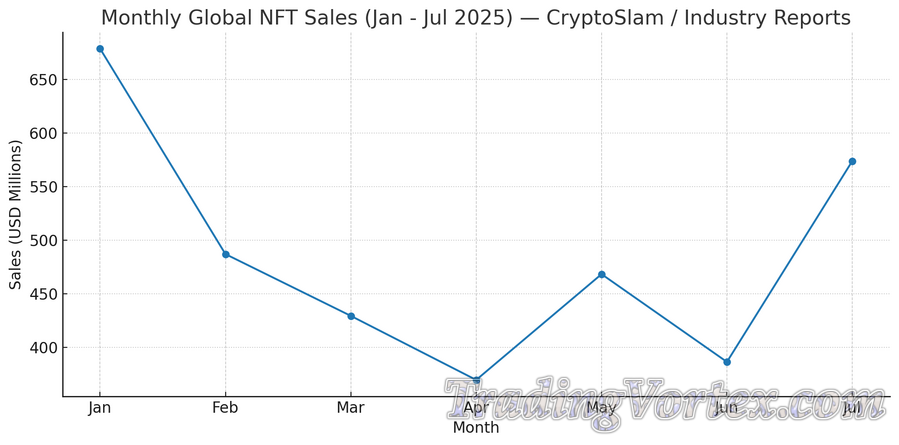 Monthly Global NFT Sales (Jan — Jul 2025):
Monthly Global NFT Sales (Jan — Jul 2025):
♦ What the chart shows: Monthly sales in USD millions for Jan through Jul 2025, plotted as a simple trend line. The data comes from CryptoSlam’s monthly figures and related industry summaries. I used the H1 2025 total to calculate February consistently with published H1 figures, then plotted January through July so you can see the mid-year dip and July rebound.
♦ Why it matters for flippers: The chart highlights a common 2025 pattern: a strong January followed by quieter months, then a notable rebound in July. For flippers this means liquidity and prices can swing quickly, so entry timing and position sizing must account for monthly volatility.
♦ Key takeaway: Treat the NFT market as cyclical in 2025: watch monthly volume trends to match your speed. If volume is contracting, downsize positions and prefer chains with lower fees to maintain margins.
 Chain Share of NFT Sales, July 2025:
Chain Share of NFT Sales, July 2025:
♦ What the chart shows: A July 2025 snapshot of chain-level sales (USD millions) with Ethereum, Bitcoin (Ordinals/Runes), Polygon, and an Other bucket. Those chain-level figures were reported in CryptoSlam-derived coverage and secondary outlets, and I used the same July total for consistency. This gives you a sense of where buyer demand concentrated that month: Ethereum led, then Bitcoin/Polygon, then other chains.
♦ Why it matters for flippers: Chain share shows where the buyers are right now. If Ethereum holds nearly half of July’s volume, blue-chip and high-value flips are likelier to find exit liquidity there. If Bitcoin and Polygon also have meaningful slices, that signals rotation opportunities for traders who monitor cross-chain flows.
♦ Key takeaway: Keep a small watchlist per chain you trade, and shift dry powder toward the chain with rising share. A chain gaining share often leads to easier exits and tighter spreads for that chain’s listings.
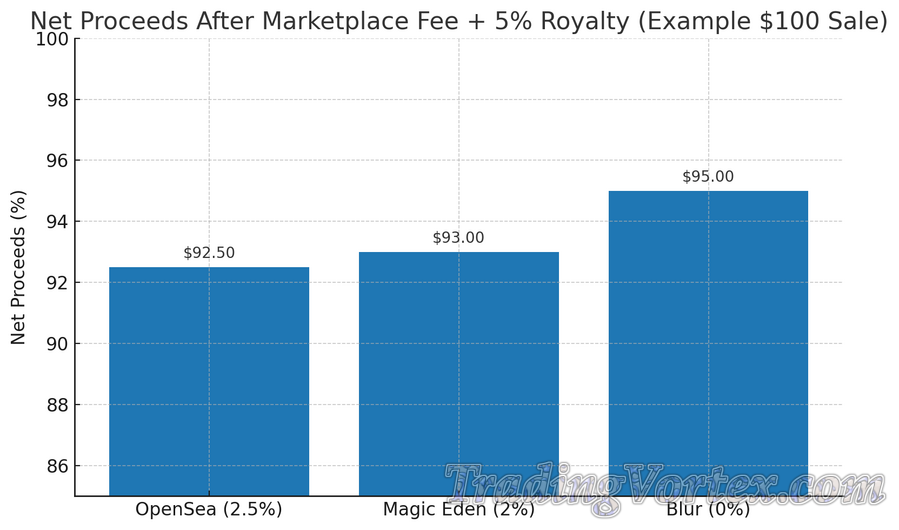 Net Proceeds After Marketplace Fee + 5% Royalty (Example $100 Sale):
Net Proceeds After Marketplace Fee + 5% Royalty (Example $100 Sale):
♦ What the chart shows: A practical illustration: suppose you sell an NFT for $100, and the creator royalty is 5%. The chart compares three marketplaces: OpenSea (2.5% marketplace fee), Magic Eden (2% transaction fee), and Blur (0% marketplace fee historically). The bar height is net percent retained after marketplace fee plus royalty, so you can compare how much cash lands in your hand. Fee numbers are sourced from the marketplaces’ public pages and recent coverage.
♦ Why it matters for flippers: Fees are not subtle. Even a few percentage points compound across dozens of trades. For example, on a $100 sale this chart shows net receipts around $92.50 on OpenSea, $93.00 on Magic Eden, and $95.00 on Blur when considering a 5% royalty. That is the difference between a small loss and a small win after many flips. Note: the bars show fees+royalty only; gas, slippage, and other costs are additional and can vary by chain.
♦ Key takeaway: Always compute a pre-trade breakeven that includes marketplace fees, royalties, and a realistic gas estimate for the chain. If the required uplift looks unlikely, skip the trade.
Ethical and Sustainable NFT Flipping:
If you plan to flip NFTs in 2025, do it in a way you can be proud of. That means supporting creators, avoiding stolen or counterfeit assets, and caring about the footprint you leave behind. Here is how I keep my trades clean, and my conscience clear.
Supporting Creator-Friendly Marketplaces:
Creator pay is not just a talking point, it is the flywheel that keeps artists and builders shipping. Marketplace rules change, so put your volume where royalties are respected.
- Favor venues that enforce royalties on-chain. Magic Eden’s Ethereum marketplace lets collections use Limit Break’s ERC-721C and Payment Processor, which can enforce programmable royalties at the contract level. If a creator opts in, trades route through a protocol that pays out automatically. That is good for artists, and it keeps incentives aligned for flippers who want healthy ecosystems.
- Know where policies stand. Rarible publicly doubled down on honoring creator fees across its platform, which is why many artists still steer collectors there. Treat these stances as signals when choosing where to list or bid.
- Expect optional royalties on some big markets. OpenSea shifted to optional “creator earnings,” which means the seller chooses the payout. If you flip there, consider paying the suggested rate, especially if you rely on that creator’s brand to hold value. Ethical behavior scales when traders normalize it.
Quick rule: if a project enforces royalties on-chain, accept the terms; if it relies on good faith, pay the creator’s ask unless there is a serious reason not to.
How to Avoid Counterfeit NFTs and Stolen Assets:
Nothing nukes a profit faster than buying a fake, or a token flagged as stolen. Build a fast pre-trade routine.
- Verify the contract from the source. Click through from the project’s official site or social profiles to the collection contract. Match the contract address on the marketplace with Etherscan, Solscan, or the chain’s explorer. Do not trust look-alike names or badges alone.
- Use marketplace protections, but do not outsource your brain. OpenSea runs a “copymint” detection system that uses image similarity to block knock-offs. It helps, yet no filter is perfect, so still check metadata, creator accounts, and mint dates.
- Respect stolen-item policies. On OpenSea, items can be frozen from sale if they are reported as stolen. As of the latest policy, the platform asks for a police report to keep or lift a theft flag, which cuts down on false claims. If you see that flag, skip the listing, even if the price looks tasty.
- Watch legal risk around IP. Big brands and major collections pursue trademark cases, and courts are still shaping the edges. A recent appellate decision in the Yuga Labs dispute shows how unsettled the landscape can be, and why trading obvious “parodies” or brand-confusing items is not worth the headache.
Red flags: mismatched creator wallet, missing or broken metadata, images hosted on sketchy domains, a “too new” collection that looks identical to a popular one, and sellers in a hurry to close off-platform.
Reduce Your Environmental Footprint:
You can flip and still be climate-aware. Chain choice matters.
- Ethereum after the Merge is far greener. Moving to proof of stake cut estimated energy use by roughly 99.95 percent. If you left in 2021, this is a different world.
- Solana publishes energy and emissions updates. The foundation regularly reports on chain-wide power use and carbon efforts, which helps teams and traders understand impact.
- Bitcoin inscriptions ride on proof of work. If you trade Ordinals, remember the network’s higher electricity profile. Cambridge maintains the most cited index for Bitcoin power consumption, so use it to inform your mix.
Practical tweaks: bundle listings when possible, avoid needless churn, prefer mints and markets that store media on efficient networks, and support projects that publish sustainability data.
Fair Play and Community Health:
Short-term wins can be expensive if you poison the well you fish in.
- Skip wash trading and fake volume. It is illegal in many places, it wrecks price discovery, and analytics firms get better at flagging it each year.
- Do not front-run your own community. If you help a project with allowlists or moderation, treat insider access with care. Disclose, size down, or sit out.
- Credit creators and respect licenses. CC0 art invites remixing for anyone, including you. Other licenses limit commercial use, so check terms before you slap a logo on merch. Creative Commons has clear guidance if you need a refresher.
A 60-Second Ethical Checklist:
- Found the official contract from official links.
- Looked for copymint or theft flags, and nothing is suspicious.
- Understood the license, CC0 or otherwise, and credited the creator when needed.
- Chose a marketplace that honors or enforces royalties where possible.
- Considered chain impact, and avoided unnecessary transactions.
You can chase alpha and still be a good actor. Pay the people who build, avoid sketchy assets, keep your trades transparent, and choose infrastructure that matches your values. Your future self, and your PnL, will thank you.
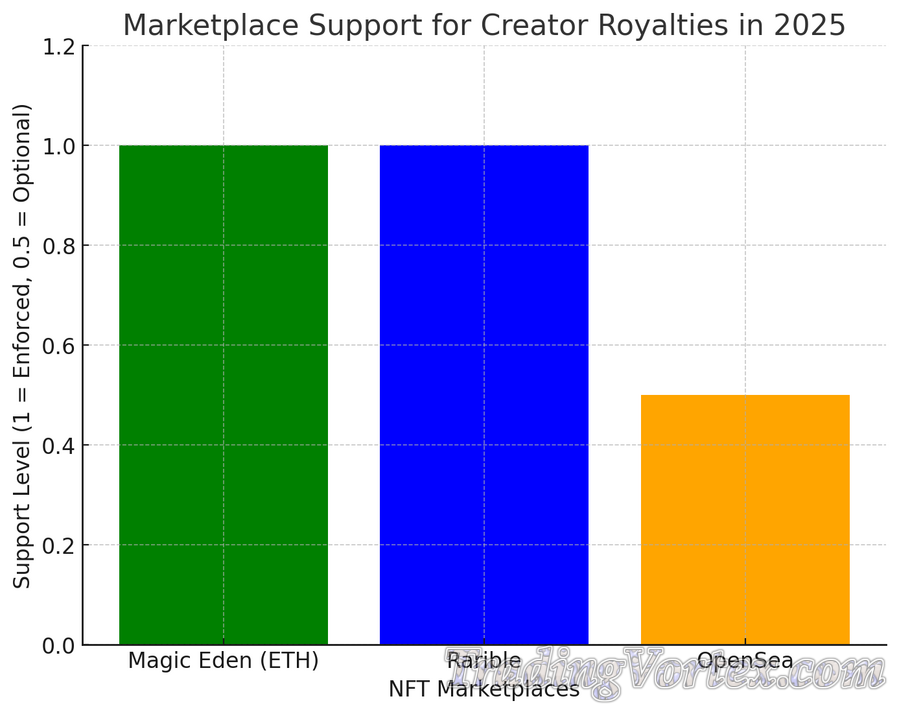 Marketplace Support for Creator Royalties in 2025: This chart compares how leading marketplaces like Magic Eden (ETH), Rarible, and OpenSea handle royalty enforcement. Magic Eden and Rarible fully enforce royalties, making them more creator-friendly, while OpenSea allows optional enforcement, which can reduce artists’ long-term earnings. This helps traders see that supporting platforms with strong royalty protection is not only ethical but also encourages a healthier ecosystem.
Marketplace Support for Creator Royalties in 2025: This chart compares how leading marketplaces like Magic Eden (ETH), Rarible, and OpenSea handle royalty enforcement. Magic Eden and Rarible fully enforce royalties, making them more creator-friendly, while OpenSea allows optional enforcement, which can reduce artists’ long-term earnings. This helps traders see that supporting platforms with strong royalty protection is not only ethical but also encourages a healthier ecosystem.
Step-by-Step Guide: Your First NFT Flip in 2025:
Alright, let’s get your first flip done without the panic sweats. We will keep it simple, keep it safe, and keep it profitable enough that you want to try again tomorrow.
Set up your wallet and lock down security:
- Pick a good wallet:
- Ethereum and L2s: MetaMask is the default for EVM chains. It shows detailed signing prompts and now includes security alerts that flag known scams.
- Solana: Phantom is popular, with transaction previews, spam filters, and built-in revoke tools.
- Add a hardware wallet for storage:
Use Ledger or Trezor to store valuable NFTs and bigger balances, then trade with a fresh hot wallet. It sounds old-school, but cold storage still saves portfolios.
- Use a “burner” wallet for mints and testing:
Keep your main assets in cold storage, mint and experiment from a separate wallet. If a contract tries something sketchy, your vault stays untouched. MetaMask and Phantom both make creating additional accounts easy.
- Revoke risky permissions regularly:
After you try new dApps or marketplaces, scan and revoke token and NFT approvals. Revoke.cash is the community standard.
- Beat the common scams:
Never sign blind “SetApprovalForAll” or permit transactions from links in DMs. Use wallet previews, compare contract addresses on explorers, and verify official links through marketplace or project pages.
Fund your wallet and choose the right chain:
- Start where fees match your bankroll:
- Ethereum Layer 2s like Base, Arbitrum, and Optimism are much cheaper after Ethereum’s Dencun upgrade introduced EIP-4844. L2 fees dropped dramatically, which is perfect for beginners who need reps without burning gas.
- Solana stays fast and inexpensive, with recent work to improve congestion and fee markets. Great for active flipping on smaller budgets.
- Bridge in safely:
If you need to move ETH to an L2, use official bridges, like Arbitrum’s or Optimism’s Standard Bridge, and follow their docs step by step. Base’s legacy bridge was deprecated, so rely on reputable third-party bridges listed in Base docs.
- Check live fees before you act:
Use Etherscan Gas Tracker on EVM and your wallet’s fee preview on Solana to avoid overpaying during spikes.
Do fast, focused research:
- Verify the collection’s official contract address:
Match the address the project shares with the one on the marketplace page, then cross-check it on Etherscan or Solscan. Many marketplaces display verified links to reduce copy-mints.
- Read the mint or collection details:
Look at supply, mint rules, and who is behind it. If the team hides everything and the contract is opaque, assume risk first. Use explorers and the marketplace description, not only social hype.
- Scan fees and royalties upfront:
OpenSea publishes its current marketplace fees and creator-earnings setup, while pro venues like Blur are known for zero marketplace fees. Your net PnL depends on these settings.
Buy your first NFT, the smart way:
- Pick a beginner-friendly venue:
- Ethereum and L2s: OpenSea for simplicity, Blur for pro-style bidding and bulk tools.
- Solana: Tensor offers real-time UIs, collection-wide bids, and market-making orders that help you buy near the floor with precision.
- Aggregators like OKX NFT show listings across chains with zero listing fees, which can reveal hidden deals.
- Use bids instead of market buys:
Place collection offers a few percentage points under floor to let impatient sellers come to you. Blur and Tensor both support this approach.
- Double-check before signing:
Confirm the collection name, token ID, price, and fee line items in your wallet preview. If anything looks off, cancel and re-open from the site’s official navigation, not from a notification pop-up.
List smart, sell cleanly, and mind your net PnL:
- Choose a listing style that fits your thesis:
- Quick flip: list slightly above floor and adjust every few hours.
- Trait premium: if you bought a rare trait, anchor higher and accept solid offers.
- Pro tip: watch the bid wall depth and recent sales velocity before you set your ask.
- Understand marketplace take-rate and creator earnings:
OpenSea currently charges a 0.5% marketplace fee on sales, and creators can configure earnings in OpenSea Studio. Blur advertises 0% marketplace fees. Your net can swing a lot on small wins.
- Track the trade from start to finish:
Use portfolio trackers with NFT support, like Zerion or NFTBank, to monitor cost basis, realized PnL, and inventory across chains. This saves pain later when you tally performance or taxes.
Wrap-up checklist you can reuse for every flip:
- Security: hardware wallet for storage, burner for mints, revoke approvals weekly.
- Fees: check Etherscan Gas Tracker on EVM, watch Solana congestion notes, and time entries when fees calm down.
- Verification: confirm the official contract via marketplace page and explorer.
- Execution: place bids near floor, avoid FOMO market buys, read the wallet preview line by line.
- PnL: account for marketplace fees, creator earnings, and gas or network fees, then log the result in your tracker.
If you follow this once, you will have the muscle memory you need. Flip number two will be calmer, flip number five will feel routine, and by flip number ten you will be the friend other beginners text for help.
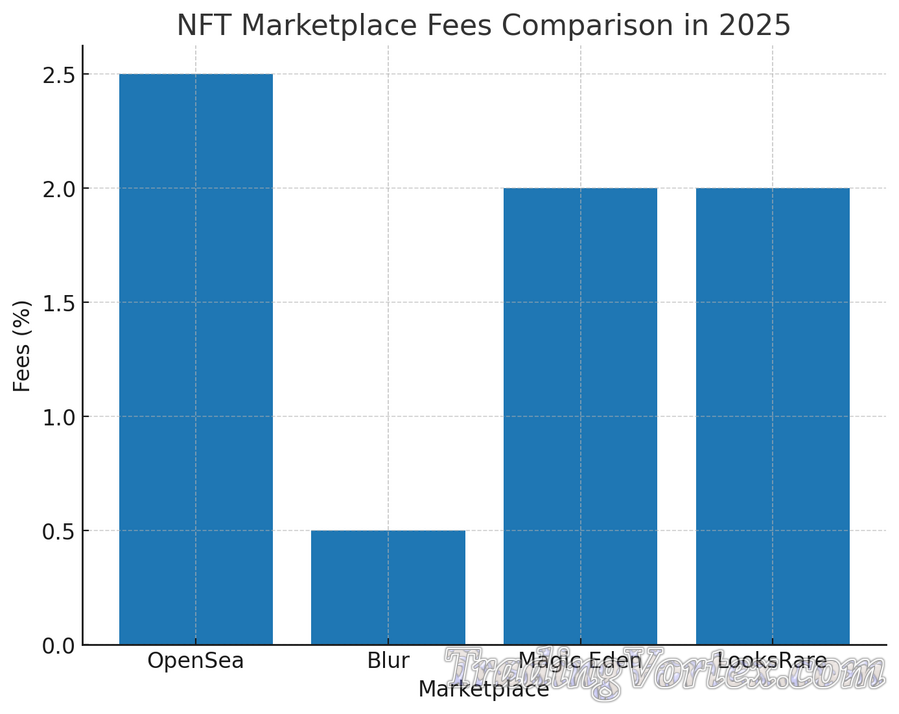 NFT Marketplace Fees Comparison in 2025: This bar chart shows the average marketplace fees across popular NFT platforms. OpenSea still charges around 2.5 percent, while Blur is known for its much lower 0.5 percent fee. Choosing the right marketplace can make a real difference in your profit margins.
NFT Marketplace Fees Comparison in 2025: This bar chart shows the average marketplace fees across popular NFT platforms. OpenSea still charges around 2.5 percent, while Blur is known for its much lower 0.5 percent fee. Choosing the right marketplace can make a real difference in your profit margins.
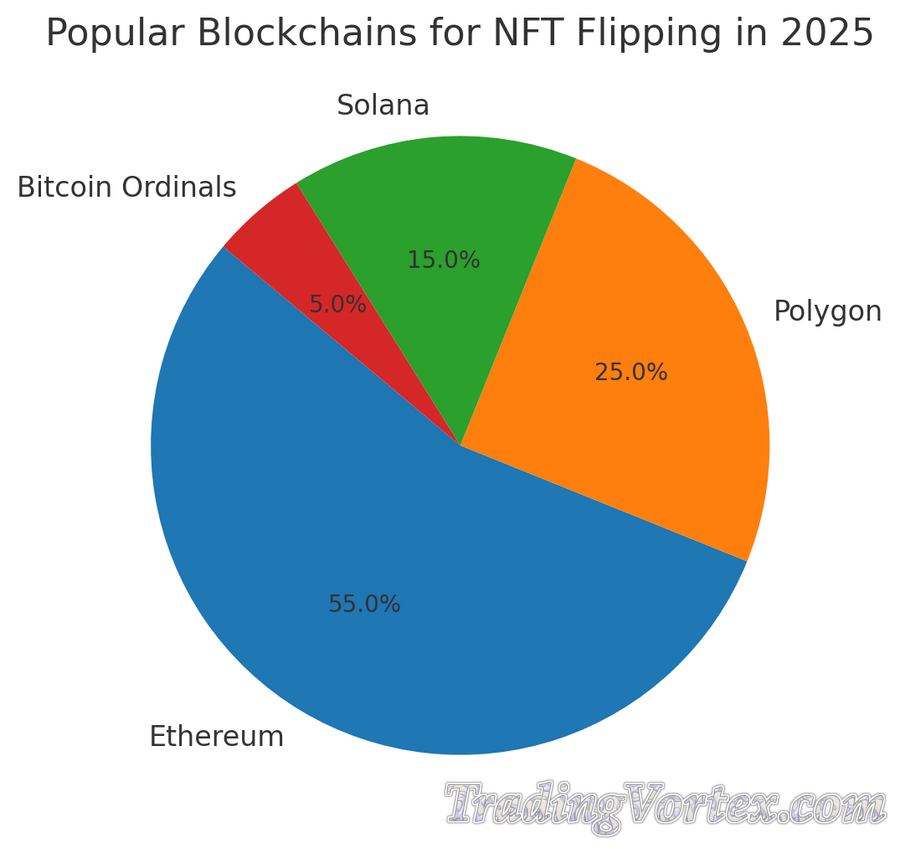 Popular Blockchains for NFT Flipping in 2025: The pie chart highlights where most NFT activity is happening. Ethereum remains dominant at 55 percent, but Polygon has carved out a strong position at 25 percent thanks to its low transaction costs. Solana holds steady with 15 percent, and Bitcoin Ordinals are attracting a niche share at 5 percent.
Popular Blockchains for NFT Flipping in 2025: The pie chart highlights where most NFT activity is happening. Ethereum remains dominant at 55 percent, but Polygon has carved out a strong position at 25 percent thanks to its low transaction costs. Solana holds steady with 15 percent, and Bitcoin Ordinals are attracting a niche share at 5 percent.
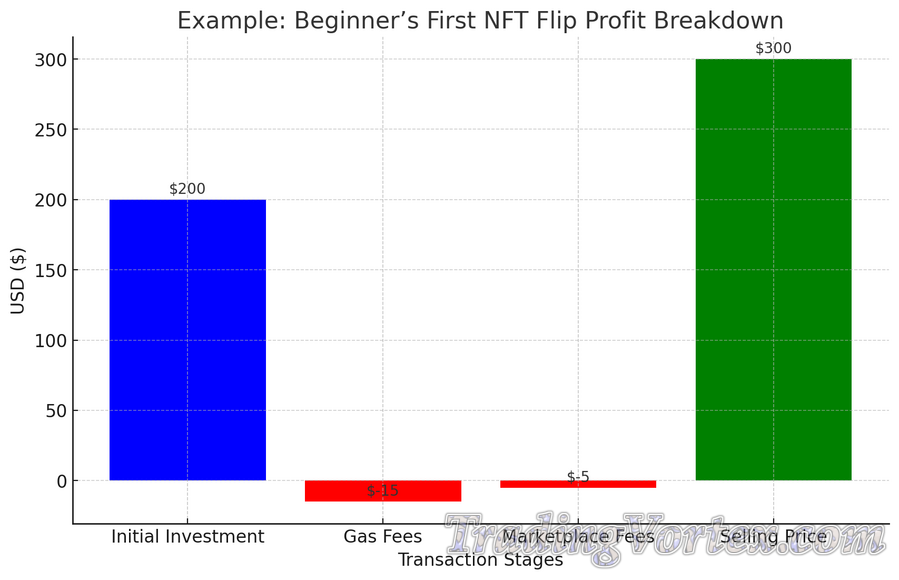 Beginner’s First NFT Flip Profit Breakdown: This bar chart breaks down a simple flip example. A beginner buys an NFT for $200, pays $15 in gas fees and $5 in marketplace fees, then sells it for $300. The result is a net profit of $80. It shows how small costs can eat into your margins and why it is important to account for them upfront.
Beginner’s First NFT Flip Profit Breakdown: This bar chart breaks down a simple flip example. A beginner buys an NFT for $200, pays $15 in gas fees and $5 in marketplace fees, then sells it for $300. The result is a net profit of $80. It shows how small costs can eat into your margins and why it is important to account for them upfront.
Advanced NFT Flipping Tactics for 2025:
Trait-Floor Arbitrage and Collection Rotations:
If you like hunting edges, trait premiums are still a reliable sandbox. The idea is simple: when a rare trait gets listed near the floor, you buy it, then relist closer to the trait’s fair value. Blur and Tensor both make this easier because you can aim bids at traits, not just the whole collection.
Blur’s v2 introduced trait-level bidding incentives, which pushed deeper liquidity into specific attributes; traders use this to “fish” for mispriced rares without babysitting the screen. Tensor supports trait bidding and shows it plainly in the workflow, so you can set automated bids that step down along a curve as fills come in. That way, your average entry price stays honest even as supply hits your bids.
A quick playbook I share with friends:
- Filter sales to the last 7 to 14 days, note the median for the traits you care about.
- Place trait bids 5 to 15 percent under that median, not under the floor, then ladder a few deeper.
- When you catch one, list at the current trait floor or slightly under to turn inventory quickly.
- Rotate to a new collection once fills slow or spreads compress; fresh narratives usually pay better than stale ones.
Automated Market Makers and Bid Pools: How to be the Liquidity?
NFT AMMs finally feel usable. On Ethereum, SudoAMM lets you run buy-only, sell-only, or two-sided pools with custom bonding curves, which is perfect if you want to market-make the chop rather than chase headlines. V2 upgraded routing and pool design, and fees can be materially lower than typical order-book marketplaces, so spread capture becomes a real strategy.
On Solana, Tensor’s AMM is the default for many collections. You can provide liquidity, set collection-wide bids that auto-decrease along a linear or exponential curve, and essentially become the counterparty to sweeps. The docs show exactly how to configure step-downs, which helps you avoid catching five NFTs at the same top tick.
Bid pools complement AMMs. Collection-wide bids on Blur and Tensor are limit orders for “any” item in the set, great for scooping capitulation. Blur’s system also tied points to risk-adjusted bidding, which taught an entire cohort how to keep real, executable bids live. The mechanics are documented across Blur’s ecosystem guides and tooling write-ups.
When does this shine: choppy ranges, post-news volatility, or during season resets when reward farmers move capital and depth thins out for a day or two.
NFT Lending, Perpetuals, and Hedging Tactics:
Using leverage safely starts with knowing your liquidation math. Blend, designed with Paradigm, is a peer-to-peer perpetual lending protocol with no oracle and no expiry; the rate is set by lenders, and positions roll as long as someone is willing to lend against that collateral. That flexibility is powerful, but it means you must watch floor drawdowns and loan-to-value, not a fixed maturity date.
Practical uses:
- Buy now, finance the rest: BNPL can stretch into higher-beta bets, but give yourself an exit rule if volume dries up. CoinDesk’s coverage explains the down-payment model clearly.
- Working capital: Borrow against an illiquid grail to fund quick flips elsewhere, then pre-commit repayments from profits. Messari’s brief flags that activity can be incentive-driven, so sanity check real demand.
If you prefer delta without custody, derivatives help. nftperp v2 offers collection-level perpetuals so you can long or short a floor with leverage on L2s like Blast or Arbitrum; the v2 docs and dashboards outline an orderbook plus AMM hybrid and typical 5x caps. Use this to hedge a bag before a risky reveal or to express a view during news. Wasabi runs on-chain perps for culture assets, letting you take directional bets without touching the JPEG; Bankless and product docs cover setup and risk.
Simple hedge template: long the rare you love, short the collection perp into a catalyst, then reduce the hedge as liquidity returns. If perps are thin, a blunt ETH short can dampen beta, although basis will vary by collection.
Execution Tips that Save Accounts:
- Pre-define slippage and size: small, repeated entries beat one oversized snipe that you cannot exit.
- Track fee friction: AMM swap fees, marketplace fees, and royalties add up; your edge is the spread after costs, not before. SudoAMM and Tensor publish fee schedules and pool mechanics in plain English.
- Respect liquidity: collection bids are not a guarantee of exit liquidity; bid walls can vanish after a snapshot or rewards epoch. The Blur ecosystem has seen this many times when incentives rotate.
- Journal your rotations: note why you entered a trait or pool, what narrative you were betting on, and what invalidates it. Your future self will thank you.
Bottom line: in 2025, the advanced edge comes from being the liquidity, not chasing it. AMMs and bid pools let you collect spreads, lending lets you finance inventory without forced sales, and perps give you a clean hedge when the room gets loud. Master those three, and you will feel much calmer through the wild parts of the cycle.
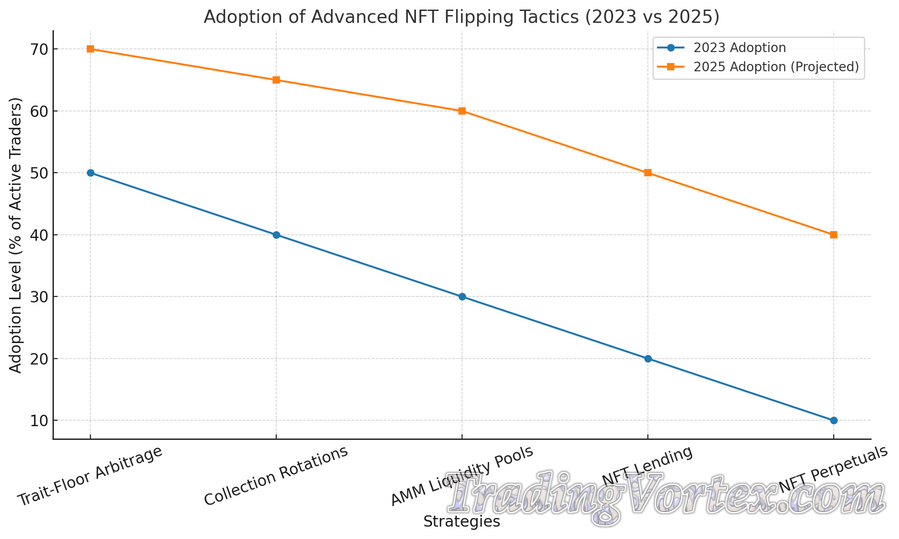 Adoption of Advanced NFT Flipping Tactics for (2023 vs 2025): a visual showing how advanced NFT flipping tactics are evolving: strategies like trait-floor arbitrage, AMM liquidity pools, and NFT lending are projected to gain significant traction by 2025 compared to 2023. This reflects how the flipping landscape is becoming more data-driven, automated, and financially sophisticated.
Adoption of Advanced NFT Flipping Tactics for (2023 vs 2025): a visual showing how advanced NFT flipping tactics are evolving: strategies like trait-floor arbitrage, AMM liquidity pools, and NFT lending are projected to gain significant traction by 2025 compared to 2023. This reflects how the flipping landscape is becoming more data-driven, automated, and financially sophisticated.
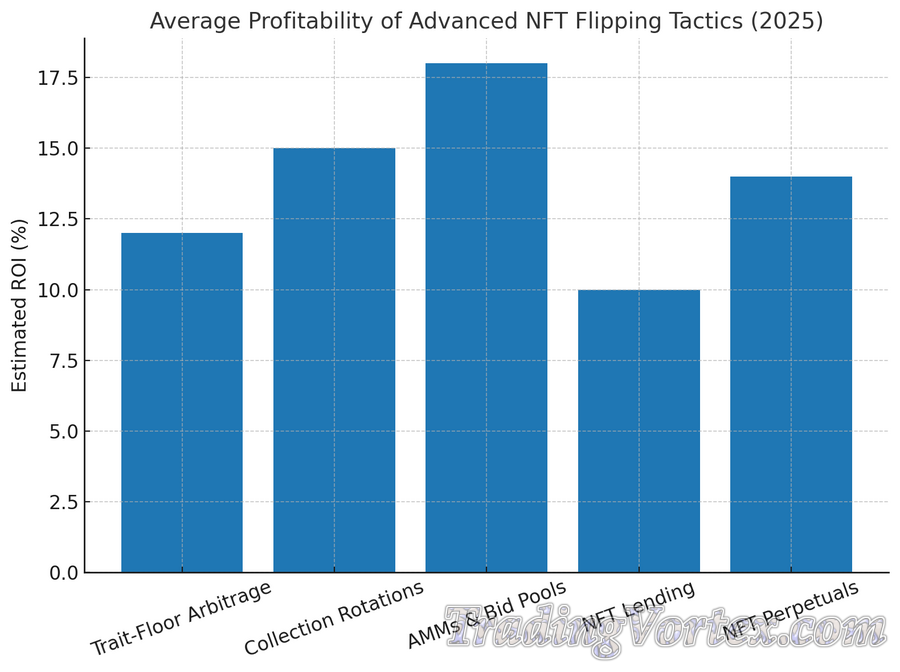 Average Profitability of Advanced NFT Flipping Tactics for (2025)
Average Profitability of Advanced NFT Flipping Tactics for (2025)
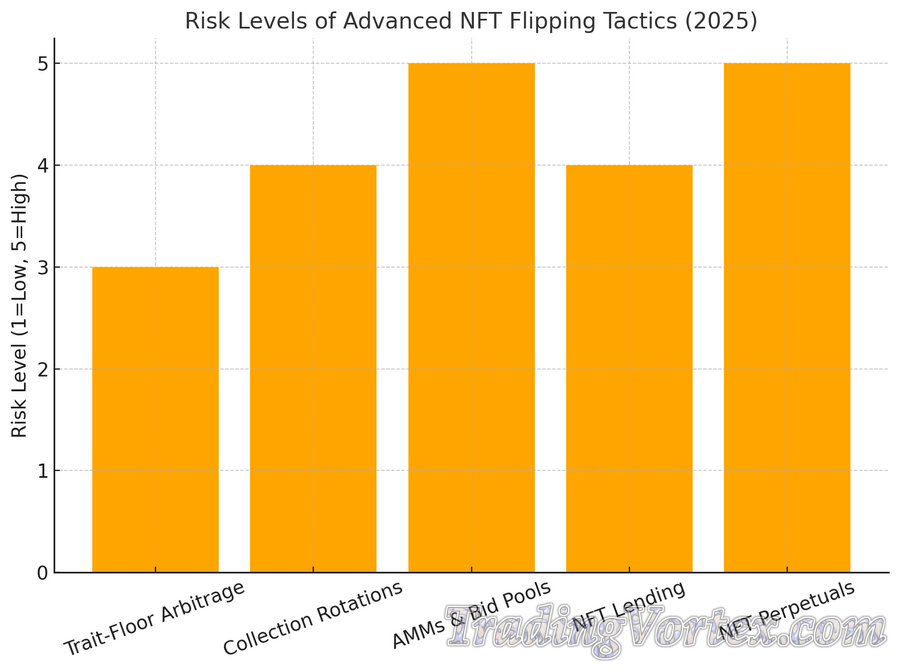 Risk Levels of Advanced NFT Flipping Tactics for (2025)
Risk Levels of Advanced NFT Flipping Tactics for (2025)
Frequently Asked Questions About NFT Flipping in 2025:
So, you're thinking about diving into the world of NFT flipping in 2025? That's awesome! But before you start minting or bidding, let's address some of the most common questions that both beginners and seasoned traders have. Think of this as your NFT flipping FAQ, packed with insights to help you navigate the space confidently.
Q1. Is NFT flipping still profitable in 2025?
Absolutely! While the market has matured since the 2021 hype, there's still money to be made. According to recent data, NFT trading volume surged by 96% in July 2025, reaching $530 million, with the average sale price more than doubling from $52 in June to $105 in July.
However, success now requires more than just luck. It's about strategy, research, and timing. Focus on projects with strong communities, real utility, and transparent roadmaps. And remember, never invest more than you can afford to lose.
Q2. How do I choose the right NFTs to flip?
Great question! Here's what to look for:
♦ Community Engagement: Check Discord and Twitter for active discussions and developer interactions.
♦ Roadmap Transparency: Ensure the project has a clear and realistic roadmap.
♦ Utility: Look for NFTs that offer real-world use cases or benefits.
♦ Creator Reputation: Verify if the creators are doxxed (publicly known) and have a history of delivering on promises.
Tools like Blur and Tensor can help you analyze floor prices and traits to spot undervalued assets.
Q3. What’s the best platform for flipping NFTs?
The choice of platform depends on your strategy:
♦ OpenSea: Ideal for long-tail listings and multichain support.
♦ Blur: Popular among professional traders for its advanced features and Blend lending.
♦ Magic Eden: Great for Solana-based NFTs and offers a user-friendly interface.
Each platform has its pros and cons, so choose the one that aligns with your flipping strategy.
Q4. How can I avoid scams and counterfeit NFTs?
Scams are unfortunately prevalent in the NFT space. To protect yourself:
♦ Verify Contracts: Always check the contract address on trusted sources like Etherscan.
♦ Use Trusted Marketplaces: Stick to well-known platforms like OpenSea and Magic Eden.
♦ Be Cautious of Links: Avoid clicking on links from unsolicited messages or emails.
♦ Check Creator Profiles: Ensure the creator's profile is verified and has a history of legitimate projects.
Staying vigilant and doing your due diligence can help you steer clear of scams.
Q5. Should I use bots or proxies for flipping?
While bots can automate buying and selling, they come with risks:
♦ Platform Policies: Many platforms have strict rules against bot usage and can ban accounts.
♦ Security Risks: Using untrusted bots or proxies can compromise your wallet's security.
If you choose to use bots, ensure they're from reputable sources and comply with platform rules. Always prioritize security and ethical practices.
Q6. What are the tax implications of NFT flipping?
Tax regulations vary by country, but generally:
♦ Capital Gains Tax: Profits from selling NFTs may be subject to capital gains tax.
♦ Record Keeping: Maintain detailed records of all transactions, including purchase and sale prices.
♦ Consult a Professional: It's advisable to consult with a tax professional familiar with cryptocurrency and NFTs to ensure compliance.
Being proactive about taxes can save you from potential issues down the line.
Q7. Can I flip NFTs with a small budget?
Yes, flipping NFTs with a small budget is possible:
♦ Focus on Undervalued Assets: Look for NFTs that are priced below their perceived value.
♦ Participate in Allowlist Drops: Some projects offer early access to NFTs at a lower price.
♦ Use Leverage Carefully: Platforms like Blend allow you to borrow against NFTs, but be cautious of the risks involved.
Starting small and scaling up as you gain experience is a prudent approach.
Q8. What are the risks involved in NFT flipping?
NFT flipping comes with several risks:
♦ Market Volatility: Prices can fluctuate wildly, leading to potential losses.
♦ Illiquidity: Some NFTs may be hard to sell quickly at a desired price.
♦ Scams and Fraud: The NFT space has its share of bad actors.
♦ Regulatory Uncertainty: Laws and regulations around NFTs are still evolving.
Understanding these risks and planning accordingly can help mitigate potential downsides.
Q9. How do I track my NFT portfolio?
Keeping track of your NFTs is crucial:
♦ Use Portfolio Trackers: Tools like Zapper and Zerion can help you monitor your holdings.
♦ Maintain a Spreadsheet: Record details of each NFT, including purchase price, current value, and platform.
♦ Regularly Review: Periodically assess your portfolio to make informed decisions.
Staying organized ensures you don't miss opportunities or overlook potential issues.
Q10. What’s the future of NFT flipping?
The future looks promising:
♦ Integration with Gaming: NFTs are increasingly being used in gaming for in-game assets.
♦ Real-World Applications: Expect more use cases in areas like ticketing, real estate, and music royalties.
♦ Regulatory Clarity: As regulations become clearer, the market may become more stable.
Staying informed and adaptable will position you well in the evolving NFT landscape.
Final Takeaway – Beginner’s Checklist for Profitable NFT Flipping:
Alright, so you've journeyed through the ins and outs of NFT flipping in 2025, and now you're ready to take the plunge. But before you dive in headfirst, let's recap the essentials with a practical checklist to guide your first profitable flip. Think of this as your NFT flipping GPS; no more getting lost in the digital wilderness.
Up Your Wallet and Secure It:
Your wallet is your digital treasure chest: treat it like one. Start by choosing a reputable wallet like MetaMask or Trust Wallet. Once set up, enable two-factor authentication (2FA) and consider using a hardware wallet for added security. Remember, if you don't control the keys, you don't control the assets.
Fund Your Wallet and Choose a Blockchain:
Load your wallet with cryptocurrency (ETH is a popular choice) through a trusted exchange. When selecting a blockchain, consider factors like transaction fees and community activity. Ethereum remains a top pick, but other blockchains like Solana and Polygon are gaining traction due to lower fees and faster transactions.
Research and Buy Your First NFT:
Don't just buy the first shiny thing you see. Research is key. Look for NFTs with strong community engagement, clear utility, and a solid roadmap. Use tools like OpenSea to analyze floor prices and trading volumes. Remember, the best flips often come from under-the-radar projects with untapped potential.
List Your NFT for Sale:
Once you've acquired your NFT, it's time to list it for sale. Choose a reputable marketplace like OpenSea or Magic Eden. Set a competitive price based on your research, and consider listing it as an auction to attract more buyers. Keep an eye on market trends to adjust your pricing strategy accordingly.
Track Your Profits and Learn from Each Flip:
After each flip, take the time to analyze what worked and what didn't. Did you buy too early or too late? Was your pricing strategy effective? Use this information to refine your approach for the next flip. Continuous learning is the key to long-term success in the NFT space.
Bonus Tip – Stay Updated and Adapt:
The NFT market is dynamic and ever-evolving. Stay informed by following industry news, joining relevant communities, and continuously educating yourself. The more adaptable you are, the better positioned you'll be to capitalize on new opportunities.
Remember, NFT flipping isn't a get-rich-quick scheme: it's a journey that requires patience, research, and a bit of luck. But with this checklist in hand, you're well on your way to navigating the NFT landscape with confidence. Happy flipping!
NFT Glossary for Beginners (ERC-404, ERC-6551, Ordinals, Runes, cNFTs):
Welcome to the NFT glossary, where we demystify some of the latest and most intriguing terms in the NFT space as of 2025. Whether you're a seasoned trader or just starting out, understanding these concepts can give you an edge in the ever-evolving world of digital assets.
ERC-404 – The Hybrid Token Standard:
Why it matters: This standard allows NFTs to be partially segmented and sold, bought, and owned in fractions by multiple users, done by linking them to a non-fungible token.
Use cases: ERC-404 can be applied in asset tokenization, DeFi, gaming, and NFTs, and supply chain management.
ERC-6551 – Token-Bound Accounts (TBAs):
Why it matters: This standard enables NFTs to function as on-chain identities, interact with decentralized applications (DApps), and hold other tokens, thereby expanding their functionality and value.
Use cases: TBAs can facilitate transactions, interact with other DApps, function as on-chain identities, or hold tokens.
Ordinals – Bitcoin’s NFT Protocol:
Why it matters: Unlike traditional NFTs that exist on separate layers, Ordinals are completely Bitcoin-native, utilizing an arbitrary but logical ordering system called ordinal theory to give each individual Bitcoin satoshi a unique number.
Use cases: Ordinals allow for the creation of unique digital assets directly on the Bitcoin blockchain, enabling the development of Bitcoin-native NFTs.
Runes – Bitcoin’s Fungible Token Standard:
Why it matters: Runes offer improved efficiency and security compared to other token standards, providing a more tailored and scalable solution for creating and managing NFTs on the Bitcoin blockchain.
Use cases: Runes can be used for creating and managing NFTs, providing a more efficient and secure alternative to other token standards.
cNFTs – Compressed NFTs on Solana:
Why it matters: By leveraging state compression, cNFTs store data in a way that drastically reduces costs, making them more scalable and cost-effective compared to traditional NFTs.
Use cases: cNFTs are ideal for projects requiring a large number of NFTs, such as gaming assets, collectibles, and other applications where cost and scalability are concerns.
Understanding these terms and their implications can enhance your ability to navigate the NFT landscape effectively. As the space continues to evolve, staying informed about new standards and protocols will help you make more informed decisions and potentially identify new opportunities for investment and innovation.





















